Impact of Change on Organisational Strategies & Operations
VerifiedAdded on 2023/01/13
|24
|7056
|21
AI Summary
This assignment discusses the impact of changes on organisational strategies and operations, change drivers, and measures to minimise negative impacts. It focuses on Unilever and BMW as case studies.
Contribute Materials
Your contribution can guide someone’s learning journey. Share your
documents today.

Understanding and
Leading Change
Leading Change
Secure Best Marks with AI Grader
Need help grading? Try our AI Grader for instant feedback on your assignments.

Table of Contents
INTRODUCTION...........................................................................................................................1
TASK 1............................................................................................................................................1
P1 Impact of changes on organisational strategies & operations................................................1
M1 Change drivers......................................................................................................................1
TASK 2............................................................................................................................................2
P2 Ways in which change drivers affect leadership and individual & team behaviour..............2
P3 Discuss measures which can be considered to minimise the negative impact of change......4
M2 Critically evaluate how organisation responds towards change...........................................4
D1 Conclusion and recommendations to planning for change...................................................5
TASK 3............................................................................................................................................6
P4 Change barriers and their influences on leadership decision-making...................................6
M3 Force field analysis...............................................................................................................7
D2 Critically evaluate force field model in order to meet organisational objectives..................8
TASK 4............................................................................................................................................8
P5 Leadership approaches to deal with changes.........................................................................8
M4 Evaluate how leadership approach can deliver organisational changes effectively.............9
D3 Critically evaluate the effectiveness of leadership approaches and models of change
management..............................................................................................................................10
CONCLUSION..............................................................................................................................10
REFERENCES..............................................................................................................................11
INTRODUCTION...........................................................................................................................1
TASK 1............................................................................................................................................1
P1 Impact of changes on organisational strategies & operations................................................1
M1 Change drivers......................................................................................................................1
TASK 2............................................................................................................................................2
P2 Ways in which change drivers affect leadership and individual & team behaviour..............2
P3 Discuss measures which can be considered to minimise the negative impact of change......4
M2 Critically evaluate how organisation responds towards change...........................................4
D1 Conclusion and recommendations to planning for change...................................................5
TASK 3............................................................................................................................................6
P4 Change barriers and their influences on leadership decision-making...................................6
M3 Force field analysis...............................................................................................................7
D2 Critically evaluate force field model in order to meet organisational objectives..................8
TASK 4............................................................................................................................................8
P5 Leadership approaches to deal with changes.........................................................................8
M4 Evaluate how leadership approach can deliver organisational changes effectively.............9
D3 Critically evaluate the effectiveness of leadership approaches and models of change
management..............................................................................................................................10
CONCLUSION..............................................................................................................................10
REFERENCES..............................................................................................................................11
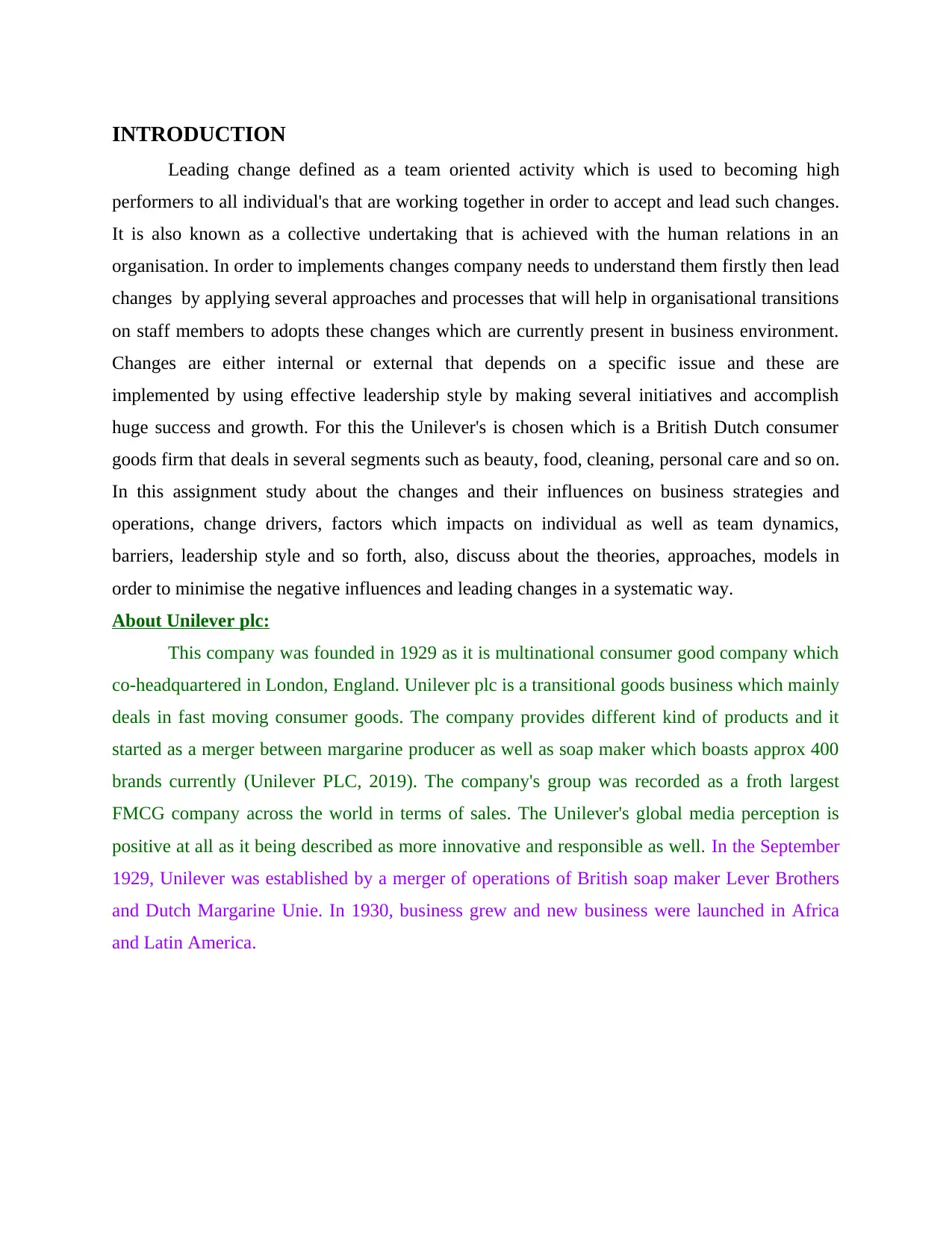
INTRODUCTION
Leading change defined as a team oriented activity which is used to becoming high
performers to all individual's that are working together in order to accept and lead such changes.
It is also known as a collective undertaking that is achieved with the human relations in an
organisation. In order to implements changes company needs to understand them firstly then lead
changes by applying several approaches and processes that will help in organisational transitions
on staff members to adopts these changes which are currently present in business environment.
Changes are either internal or external that depends on a specific issue and these are
implemented by using effective leadership style by making several initiatives and accomplish
huge success and growth. For this the Unilever's is chosen which is a British Dutch consumer
goods firm that deals in several segments such as beauty, food, cleaning, personal care and so on.
In this assignment study about the changes and their influences on business strategies and
operations, change drivers, factors which impacts on individual as well as team dynamics,
barriers, leadership style and so forth, also, discuss about the theories, approaches, models in
order to minimise the negative influences and leading changes in a systematic way.
About Unilever plc:
This company was founded in 1929 as it is multinational consumer good company which
co-headquartered in London, England. Unilever plc is a transitional goods business which mainly
deals in fast moving consumer goods. The company provides different kind of products and it
started as a merger between margarine producer as well as soap maker which boasts approx 400
brands currently (Unilever PLC, 2019). The company's group was recorded as a froth largest
FMCG company across the world in terms of sales. The Unilever's global media perception is
positive at all as it being described as more innovative and responsible as well. In the September
1929, Unilever was established by a merger of operations of British soap maker Lever Brothers
and Dutch Margarine Unie. In 1930, business grew and new business were launched in Africa
and Latin America.
Leading change defined as a team oriented activity which is used to becoming high
performers to all individual's that are working together in order to accept and lead such changes.
It is also known as a collective undertaking that is achieved with the human relations in an
organisation. In order to implements changes company needs to understand them firstly then lead
changes by applying several approaches and processes that will help in organisational transitions
on staff members to adopts these changes which are currently present in business environment.
Changes are either internal or external that depends on a specific issue and these are
implemented by using effective leadership style by making several initiatives and accomplish
huge success and growth. For this the Unilever's is chosen which is a British Dutch consumer
goods firm that deals in several segments such as beauty, food, cleaning, personal care and so on.
In this assignment study about the changes and their influences on business strategies and
operations, change drivers, factors which impacts on individual as well as team dynamics,
barriers, leadership style and so forth, also, discuss about the theories, approaches, models in
order to minimise the negative influences and leading changes in a systematic way.
About Unilever plc:
This company was founded in 1929 as it is multinational consumer good company which
co-headquartered in London, England. Unilever plc is a transitional goods business which mainly
deals in fast moving consumer goods. The company provides different kind of products and it
started as a merger between margarine producer as well as soap maker which boasts approx 400
brands currently (Unilever PLC, 2019). The company's group was recorded as a froth largest
FMCG company across the world in terms of sales. The Unilever's global media perception is
positive at all as it being described as more innovative and responsible as well. In the September
1929, Unilever was established by a merger of operations of British soap maker Lever Brothers
and Dutch Margarine Unie. In 1930, business grew and new business were launched in Africa
and Latin America.

(Source : Unilever Organizational Chart, 2020)
TASK 1
P1 Organisations where there has been an impact on organisation's strategy and operations
Organisational strategies are the set plans, actions and structures which are formulated by
the management so that the objectives of company can be achieved in an efficient manner which
can help it in dealing with change and gain a competitive advantage in the market. The dynamic
business environment must be efficiently analysed so that the drivers of change and their impact
on company policies can be known. This helps the management in changing organisational
strategies so that the negative impact of change does not affect company's existence in
marketplace:
Basis Unilever BMW
Political
changes
Impact: As there has been an
uncertainty due to Brexit the retail
sector of UK has been impacted
because the trade from EU has become
expensive, spending by customers on
Impact: Due to uncertainty in Brexit the
import of parts which are required to
manufacture cars from EU has become
expensive and also there is a fear of
loosing EU market which is a large
TASK 1
P1 Organisations where there has been an impact on organisation's strategy and operations
Organisational strategies are the set plans, actions and structures which are formulated by
the management so that the objectives of company can be achieved in an efficient manner which
can help it in dealing with change and gain a competitive advantage in the market. The dynamic
business environment must be efficiently analysed so that the drivers of change and their impact
on company policies can be known. This helps the management in changing organisational
strategies so that the negative impact of change does not affect company's existence in
marketplace:
Basis Unilever BMW
Political
changes
Impact: As there has been an
uncertainty due to Brexit the retail
sector of UK has been impacted
because the trade from EU has become
expensive, spending by customers on
Impact: Due to uncertainty in Brexit the
import of parts which are required to
manufacture cars from EU has become
expensive and also there is a fear of
loosing EU market which is a large
Secure Best Marks with AI Grader
Need help grading? Try our AI Grader for instant feedback on your assignments.
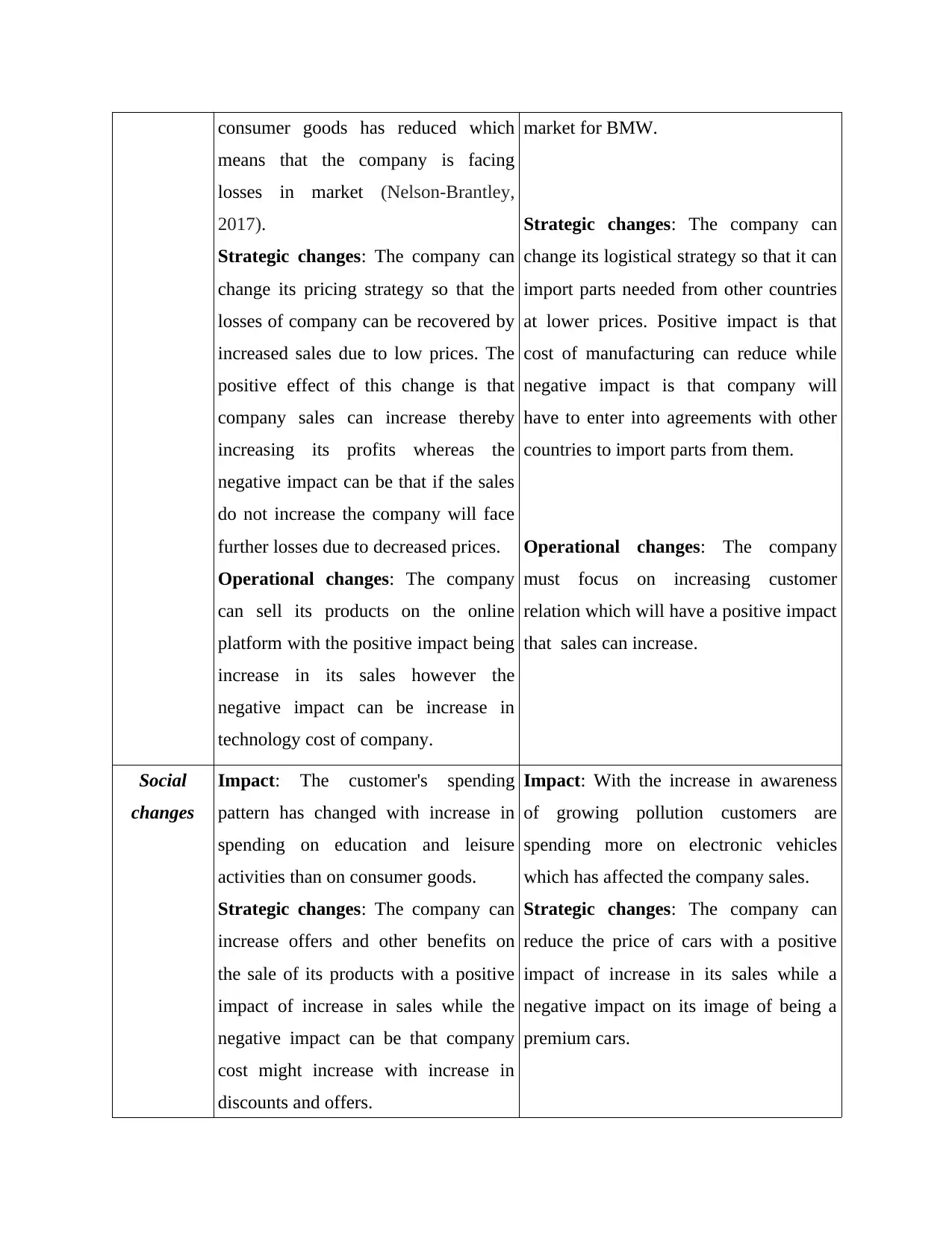
consumer goods has reduced which
means that the company is facing
losses in market (Nelson‐Brantley,
2017).
Strategic changes: The company can
change its pricing strategy so that the
losses of company can be recovered by
increased sales due to low prices. The
positive effect of this change is that
company sales can increase thereby
increasing its profits whereas the
negative impact can be that if the sales
do not increase the company will face
further losses due to decreased prices.
Operational changes: The company
can sell its products on the online
platform with the positive impact being
increase in its sales however the
negative impact can be increase in
technology cost of company.
market for BMW.
Strategic changes: The company can
change its logistical strategy so that it can
import parts needed from other countries
at lower prices. Positive impact is that
cost of manufacturing can reduce while
negative impact is that company will
have to enter into agreements with other
countries to import parts from them.
Operational changes: The company
must focus on increasing customer
relation which will have a positive impact
that sales can increase.
Social
changes
Impact: The customer's spending
pattern has changed with increase in
spending on education and leisure
activities than on consumer goods.
Strategic changes: The company can
increase offers and other benefits on
the sale of its products with a positive
impact of increase in sales while the
negative impact can be that company
cost might increase with increase in
discounts and offers.
Impact: With the increase in awareness
of growing pollution customers are
spending more on electronic vehicles
which has affected the company sales.
Strategic changes: The company can
reduce the price of cars with a positive
impact of increase in its sales while a
negative impact on its image of being a
premium cars.
means that the company is facing
losses in market (Nelson‐Brantley,
2017).
Strategic changes: The company can
change its pricing strategy so that the
losses of company can be recovered by
increased sales due to low prices. The
positive effect of this change is that
company sales can increase thereby
increasing its profits whereas the
negative impact can be that if the sales
do not increase the company will face
further losses due to decreased prices.
Operational changes: The company
can sell its products on the online
platform with the positive impact being
increase in its sales however the
negative impact can be increase in
technology cost of company.
market for BMW.
Strategic changes: The company can
change its logistical strategy so that it can
import parts needed from other countries
at lower prices. Positive impact is that
cost of manufacturing can reduce while
negative impact is that company will
have to enter into agreements with other
countries to import parts from them.
Operational changes: The company
must focus on increasing customer
relation which will have a positive impact
that sales can increase.
Social
changes
Impact: The customer's spending
pattern has changed with increase in
spending on education and leisure
activities than on consumer goods.
Strategic changes: The company can
increase offers and other benefits on
the sale of its products with a positive
impact of increase in sales while the
negative impact can be that company
cost might increase with increase in
discounts and offers.
Impact: With the increase in awareness
of growing pollution customers are
spending more on electronic vehicles
which has affected the company sales.
Strategic changes: The company can
reduce the price of cars with a positive
impact of increase in its sales while a
negative impact on its image of being a
premium cars.

Operational change: The company
can include return and refund policies
with a positive impact of increased
trust whereas the negative impact of
increased company inventory
(Muluneh, 2018).
Operational change: The company can
include such parts in vehicles which
reduce pollution with a positive impact
on sales and environment whereas a
negative impact of increase in
technological change.
Impact of changes:
Within the context of businesses, changes are negatively as well as positively impact on
operational strategies and operations that will lead the result of changes in team, individual and
leadership style in positive as well as negative manner. It shows as follows:
Changes
impact on
Positive impact of changes Negative impact of changes
Leadership As changes in both organisations BMW
and Unilever's helps in developing the
leadership styles of leaders because due
to the political and social changes
leaders need to be require formulate
changes in their styles so it helps in
leading team in effective manner.
Whereas, changes may negatively
impacts on leadership styles in
Unilever and BMW because to lead
followers and influence team
members towards the changes are
sometimes difficult.
Team Changes positively helps in being a
team oriented environment at
workplace of both the organisations
because a single change is adopted by
all the team members with the large
number of new ideas which makes team
more effective.
But these changes creates disputes
and conflicts among all members of
team that are formed in BMW and
Unilever for the purpose of
performing activities together. This is
to be done because of the availability
of different opinions which are not
possible to considered on a single
change or for accomplishing team
can include return and refund policies
with a positive impact of increased
trust whereas the negative impact of
increased company inventory
(Muluneh, 2018).
Operational change: The company can
include such parts in vehicles which
reduce pollution with a positive impact
on sales and environment whereas a
negative impact of increase in
technological change.
Impact of changes:
Within the context of businesses, changes are negatively as well as positively impact on
operational strategies and operations that will lead the result of changes in team, individual and
leadership style in positive as well as negative manner. It shows as follows:
Changes
impact on
Positive impact of changes Negative impact of changes
Leadership As changes in both organisations BMW
and Unilever's helps in developing the
leadership styles of leaders because due
to the political and social changes
leaders need to be require formulate
changes in their styles so it helps in
leading team in effective manner.
Whereas, changes may negatively
impacts on leadership styles in
Unilever and BMW because to lead
followers and influence team
members towards the changes are
sometimes difficult.
Team Changes positively helps in being a
team oriented environment at
workplace of both the organisations
because a single change is adopted by
all the team members with the large
number of new ideas which makes team
more effective.
But these changes creates disputes
and conflicts among all members of
team that are formed in BMW and
Unilever for the purpose of
performing activities together. This is
to be done because of the availability
of different opinions which are not
possible to considered on a single
change or for accomplishing team
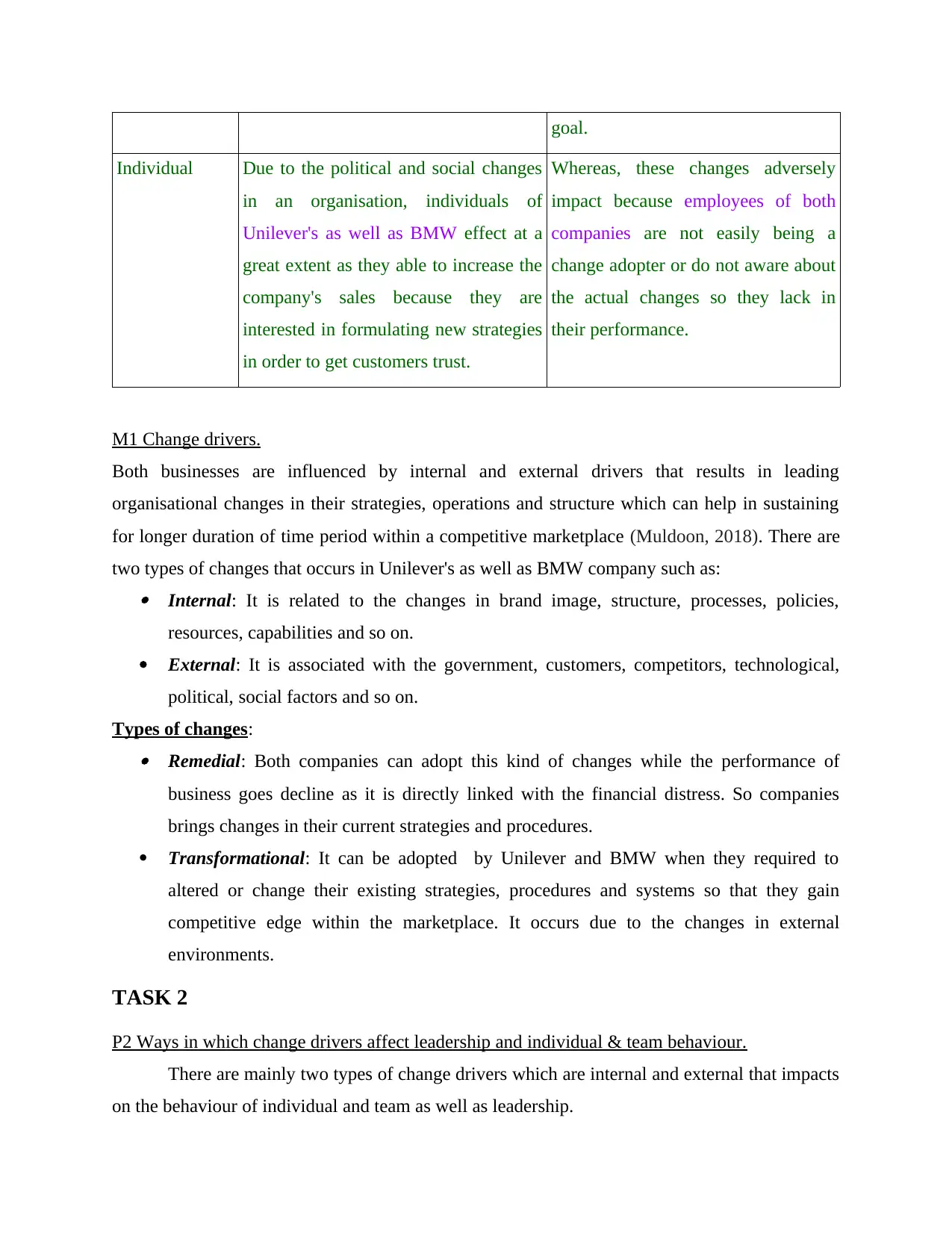
goal.
Individual Due to the political and social changes
in an organisation, individuals of
Unilever's as well as BMW effect at a
great extent as they able to increase the
company's sales because they are
interested in formulating new strategies
in order to get customers trust.
Whereas, these changes adversely
impact because employees of both
companies are not easily being a
change adopter or do not aware about
the actual changes so they lack in
their performance.
M1 Change drivers.
Both businesses are influenced by internal and external drivers that results in leading
organisational changes in their strategies, operations and structure which can help in sustaining
for longer duration of time period within a competitive marketplace (Muldoon, 2018). There are
two types of changes that occurs in Unilever's as well as BMW company such as: Internal: It is related to the changes in brand image, structure, processes, policies,
resources, capabilities and so on.
External: It is associated with the government, customers, competitors, technological,
political, social factors and so on.
Types of changes: Remedial: Both companies can adopt this kind of changes while the performance of
business goes decline as it is directly linked with the financial distress. So companies
brings changes in their current strategies and procedures.
Transformational: It can be adopted by Unilever and BMW when they required to
altered or change their existing strategies, procedures and systems so that they gain
competitive edge within the marketplace. It occurs due to the changes in external
environments.
TASK 2
P2 Ways in which change drivers affect leadership and individual & team behaviour.
There are mainly two types of change drivers which are internal and external that impacts
on the behaviour of individual and team as well as leadership.
Individual Due to the political and social changes
in an organisation, individuals of
Unilever's as well as BMW effect at a
great extent as they able to increase the
company's sales because they are
interested in formulating new strategies
in order to get customers trust.
Whereas, these changes adversely
impact because employees of both
companies are not easily being a
change adopter or do not aware about
the actual changes so they lack in
their performance.
M1 Change drivers.
Both businesses are influenced by internal and external drivers that results in leading
organisational changes in their strategies, operations and structure which can help in sustaining
for longer duration of time period within a competitive marketplace (Muldoon, 2018). There are
two types of changes that occurs in Unilever's as well as BMW company such as: Internal: It is related to the changes in brand image, structure, processes, policies,
resources, capabilities and so on.
External: It is associated with the government, customers, competitors, technological,
political, social factors and so on.
Types of changes: Remedial: Both companies can adopt this kind of changes while the performance of
business goes decline as it is directly linked with the financial distress. So companies
brings changes in their current strategies and procedures.
Transformational: It can be adopted by Unilever and BMW when they required to
altered or change their existing strategies, procedures and systems so that they gain
competitive edge within the marketplace. It occurs due to the changes in external
environments.
TASK 2
P2 Ways in which change drivers affect leadership and individual & team behaviour.
There are mainly two types of change drivers which are internal and external that impacts
on the behaviour of individual and team as well as leadership.
Paraphrase This Document
Need a fresh take? Get an instant paraphrase of this document with our AI Paraphraser
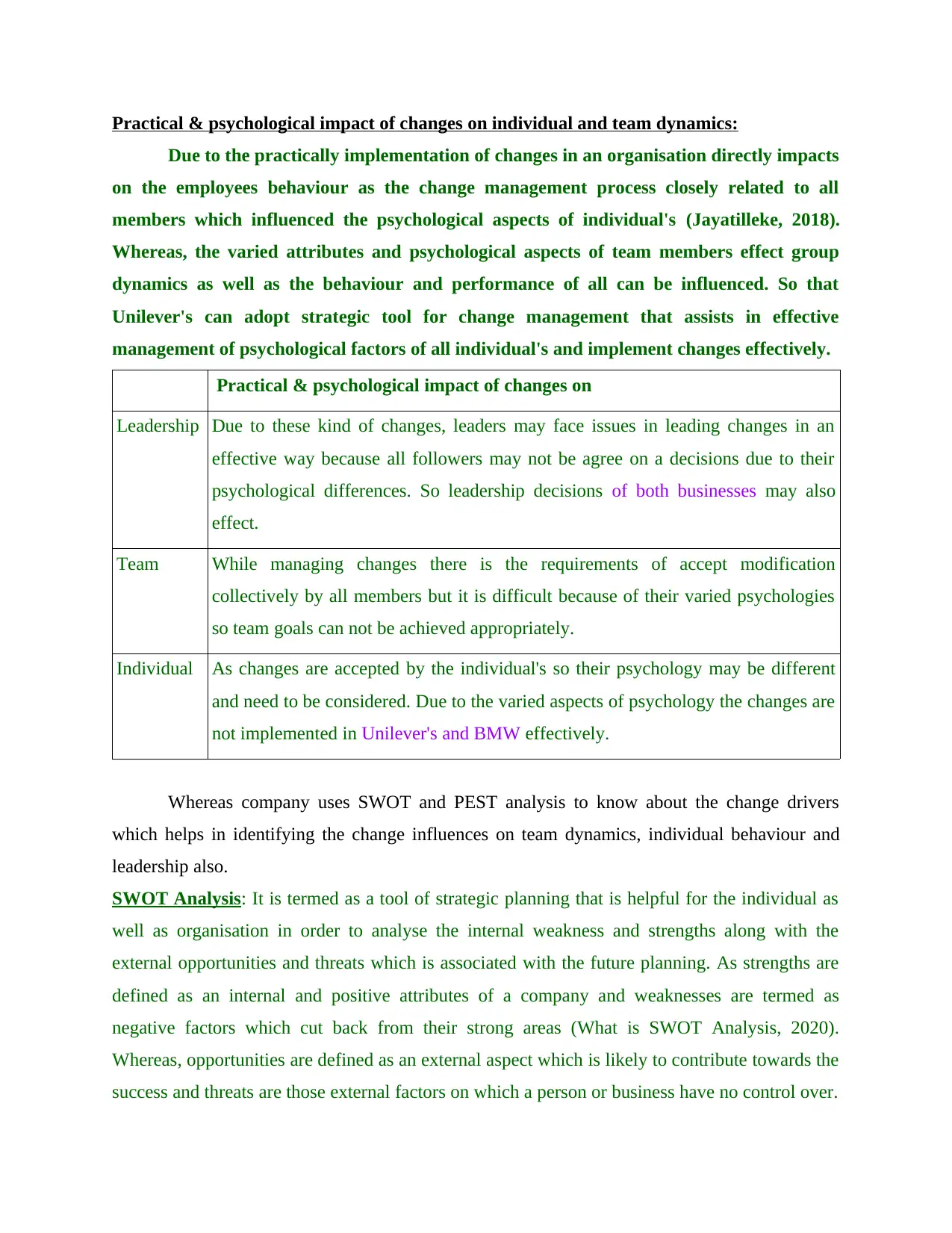
Practical & psychological impact of changes on individual and team dynamics:
Due to the practically implementation of changes in an organisation directly impacts
on the employees behaviour as the change management process closely related to all
members which influenced the psychological aspects of individual's (Jayatilleke, 2018).
Whereas, the varied attributes and psychological aspects of team members effect group
dynamics as well as the behaviour and performance of all can be influenced. So that
Unilever's can adopt strategic tool for change management that assists in effective
management of psychological factors of all individual's and implement changes effectively.
Practical & psychological impact of changes on
Leadership Due to these kind of changes, leaders may face issues in leading changes in an
effective way because all followers may not be agree on a decisions due to their
psychological differences. So leadership decisions of both businesses may also
effect.
Team While managing changes there is the requirements of accept modification
collectively by all members but it is difficult because of their varied psychologies
so team goals can not be achieved appropriately.
Individual As changes are accepted by the individual's so their psychology may be different
and need to be considered. Due to the varied aspects of psychology the changes are
not implemented in Unilever's and BMW effectively.
Whereas company uses SWOT and PEST analysis to know about the change drivers
which helps in identifying the change influences on team dynamics, individual behaviour and
leadership also.
SWOT Analysis: It is termed as a tool of strategic planning that is helpful for the individual as
well as organisation in order to analyse the internal weakness and strengths along with the
external opportunities and threats which is associated with the future planning. As strengths are
defined as an internal and positive attributes of a company and weaknesses are termed as
negative factors which cut back from their strong areas (What is SWOT Analysis, 2020).
Whereas, opportunities are defined as an external aspect which is likely to contribute towards the
success and threats are those external factors on which a person or business have no control over.
Due to the practically implementation of changes in an organisation directly impacts
on the employees behaviour as the change management process closely related to all
members which influenced the psychological aspects of individual's (Jayatilleke, 2018).
Whereas, the varied attributes and psychological aspects of team members effect group
dynamics as well as the behaviour and performance of all can be influenced. So that
Unilever's can adopt strategic tool for change management that assists in effective
management of psychological factors of all individual's and implement changes effectively.
Practical & psychological impact of changes on
Leadership Due to these kind of changes, leaders may face issues in leading changes in an
effective way because all followers may not be agree on a decisions due to their
psychological differences. So leadership decisions of both businesses may also
effect.
Team While managing changes there is the requirements of accept modification
collectively by all members but it is difficult because of their varied psychologies
so team goals can not be achieved appropriately.
Individual As changes are accepted by the individual's so their psychology may be different
and need to be considered. Due to the varied aspects of psychology the changes are
not implemented in Unilever's and BMW effectively.
Whereas company uses SWOT and PEST analysis to know about the change drivers
which helps in identifying the change influences on team dynamics, individual behaviour and
leadership also.
SWOT Analysis: It is termed as a tool of strategic planning that is helpful for the individual as
well as organisation in order to analyse the internal weakness and strengths along with the
external opportunities and threats which is associated with the future planning. As strengths are
defined as an internal and positive attributes of a company and weaknesses are termed as
negative factors which cut back from their strong areas (What is SWOT Analysis, 2020).
Whereas, opportunities are defined as an external aspect which is likely to contribute towards the
success and threats are those external factors on which a person or business have no control over.
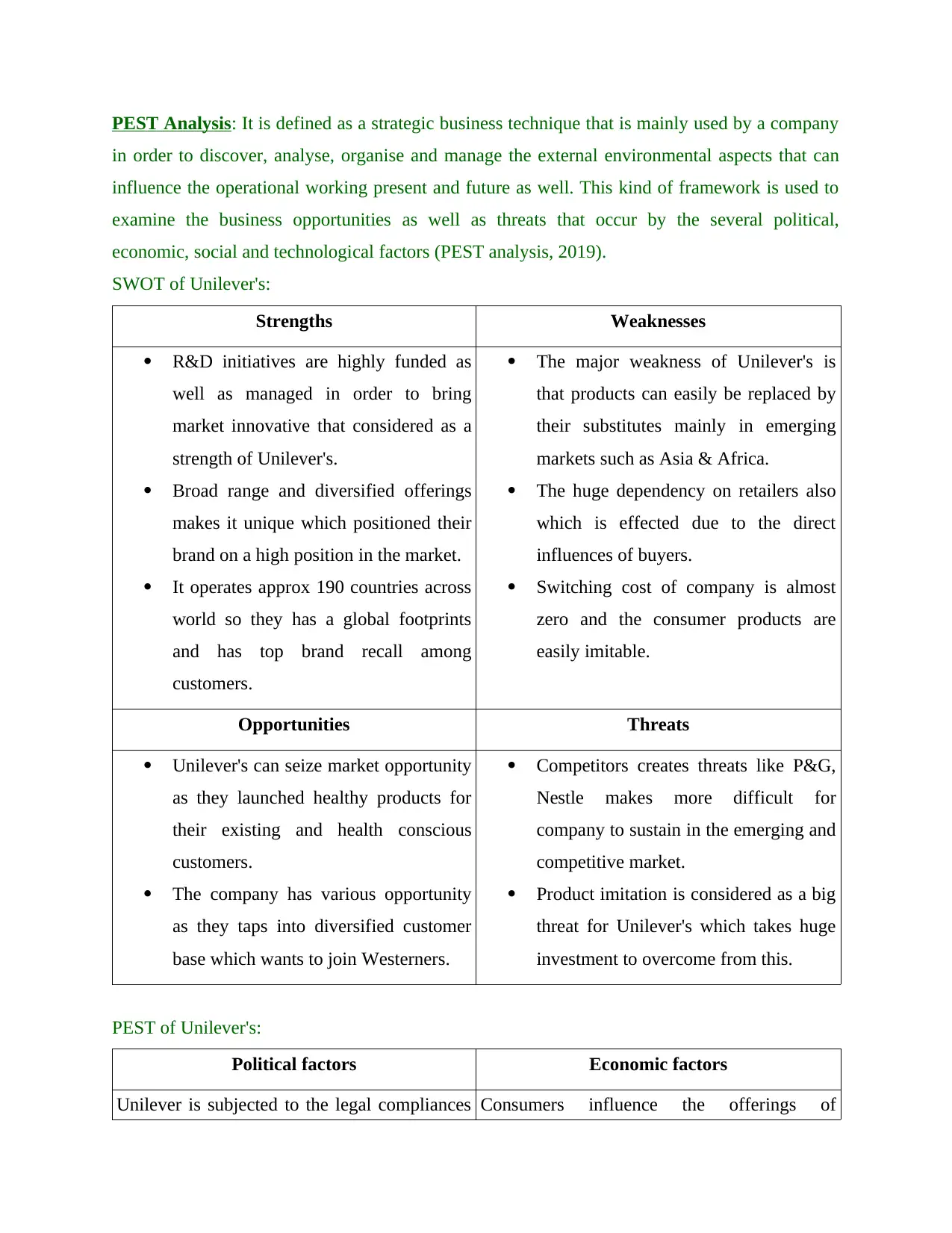
PEST Analysis: It is defined as a strategic business technique that is mainly used by a company
in order to discover, analyse, organise and manage the external environmental aspects that can
influence the operational working present and future as well. This kind of framework is used to
examine the business opportunities as well as threats that occur by the several political,
economic, social and technological factors (PEST analysis, 2019).
SWOT of Unilever's:
Strengths Weaknesses
R&D initiatives are highly funded as
well as managed in order to bring
market innovative that considered as a
strength of Unilever's.
Broad range and diversified offerings
makes it unique which positioned their
brand on a high position in the market.
It operates approx 190 countries across
world so they has a global footprints
and has top brand recall among
customers.
The major weakness of Unilever's is
that products can easily be replaced by
their substitutes mainly in emerging
markets such as Asia & Africa.
The huge dependency on retailers also
which is effected due to the direct
influences of buyers.
Switching cost of company is almost
zero and the consumer products are
easily imitable.
Opportunities Threats
Unilever's can seize market opportunity
as they launched healthy products for
their existing and health conscious
customers.
The company has various opportunity
as they taps into diversified customer
base which wants to join Westerners.
Competitors creates threats like P&G,
Nestle makes more difficult for
company to sustain in the emerging and
competitive market.
Product imitation is considered as a big
threat for Unilever's which takes huge
investment to overcome from this.
PEST of Unilever's:
Political factors Economic factors
Unilever is subjected to the legal compliances Consumers influence the offerings of
in order to discover, analyse, organise and manage the external environmental aspects that can
influence the operational working present and future as well. This kind of framework is used to
examine the business opportunities as well as threats that occur by the several political,
economic, social and technological factors (PEST analysis, 2019).
SWOT of Unilever's:
Strengths Weaknesses
R&D initiatives are highly funded as
well as managed in order to bring
market innovative that considered as a
strength of Unilever's.
Broad range and diversified offerings
makes it unique which positioned their
brand on a high position in the market.
It operates approx 190 countries across
world so they has a global footprints
and has top brand recall among
customers.
The major weakness of Unilever's is
that products can easily be replaced by
their substitutes mainly in emerging
markets such as Asia & Africa.
The huge dependency on retailers also
which is effected due to the direct
influences of buyers.
Switching cost of company is almost
zero and the consumer products are
easily imitable.
Opportunities Threats
Unilever's can seize market opportunity
as they launched healthy products for
their existing and health conscious
customers.
The company has various opportunity
as they taps into diversified customer
base which wants to join Westerners.
Competitors creates threats like P&G,
Nestle makes more difficult for
company to sustain in the emerging and
competitive market.
Product imitation is considered as a big
threat for Unilever's which takes huge
investment to overcome from this.
PEST of Unilever's:
Political factors Economic factors
Unilever is subjected to the legal compliances Consumers influence the offerings of
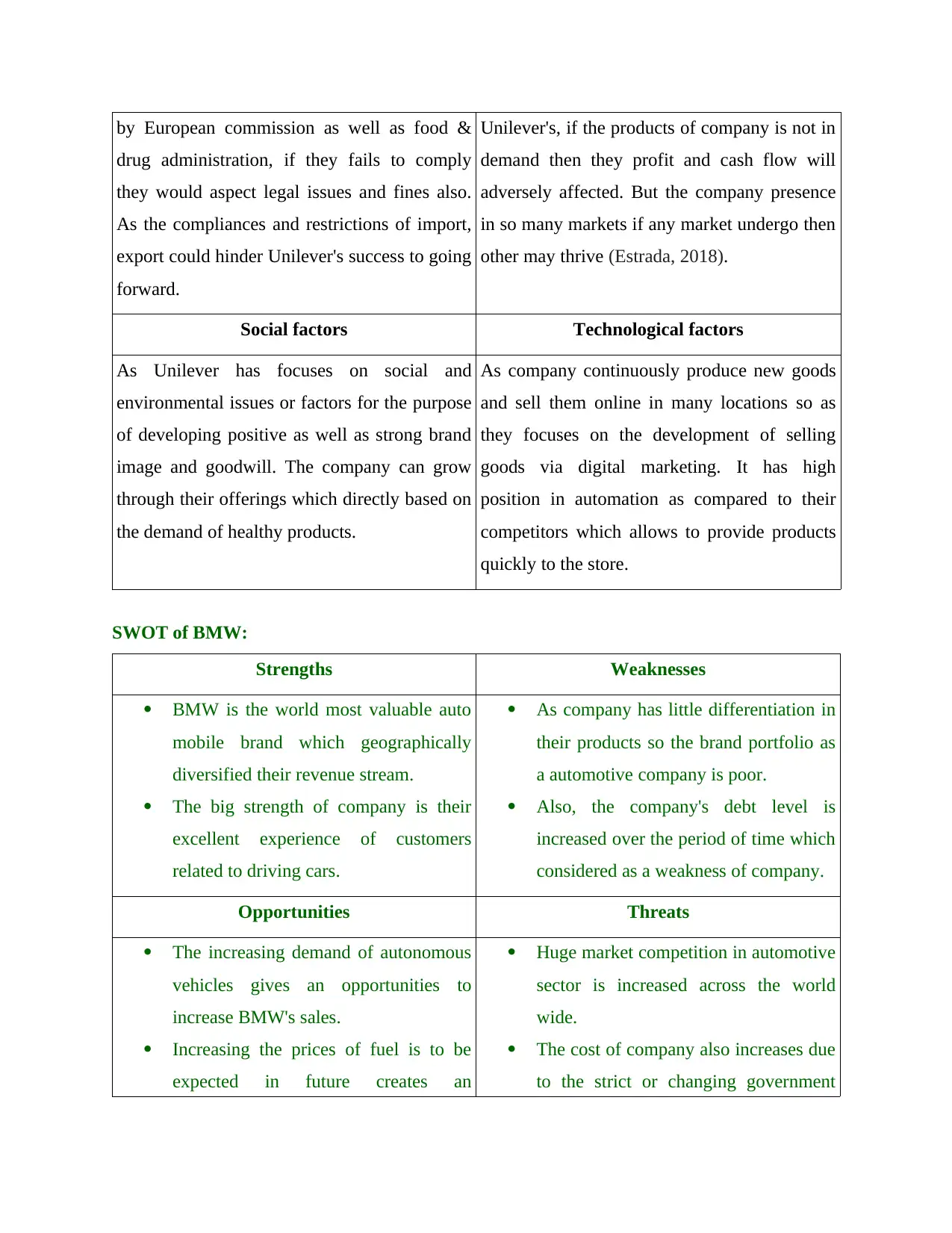
by European commission as well as food &
drug administration, if they fails to comply
they would aspect legal issues and fines also.
As the compliances and restrictions of import,
export could hinder Unilever's success to going
forward.
Unilever's, if the products of company is not in
demand then they profit and cash flow will
adversely affected. But the company presence
in so many markets if any market undergo then
other may thrive (Estrada, 2018).
Social factors Technological factors
As Unilever has focuses on social and
environmental issues or factors for the purpose
of developing positive as well as strong brand
image and goodwill. The company can grow
through their offerings which directly based on
the demand of healthy products.
As company continuously produce new goods
and sell them online in many locations so as
they focuses on the development of selling
goods via digital marketing. It has high
position in automation as compared to their
competitors which allows to provide products
quickly to the store.
SWOT of BMW:
Strengths Weaknesses
BMW is the world most valuable auto
mobile brand which geographically
diversified their revenue stream.
The big strength of company is their
excellent experience of customers
related to driving cars.
As company has little differentiation in
their products so the brand portfolio as
a automotive company is poor.
Also, the company's debt level is
increased over the period of time which
considered as a weakness of company.
Opportunities Threats
The increasing demand of autonomous
vehicles gives an opportunities to
increase BMW's sales.
Increasing the prices of fuel is to be
expected in future creates an
Huge market competition in automotive
sector is increased across the world
wide.
The cost of company also increases due
to the strict or changing government
drug administration, if they fails to comply
they would aspect legal issues and fines also.
As the compliances and restrictions of import,
export could hinder Unilever's success to going
forward.
Unilever's, if the products of company is not in
demand then they profit and cash flow will
adversely affected. But the company presence
in so many markets if any market undergo then
other may thrive (Estrada, 2018).
Social factors Technological factors
As Unilever has focuses on social and
environmental issues or factors for the purpose
of developing positive as well as strong brand
image and goodwill. The company can grow
through their offerings which directly based on
the demand of healthy products.
As company continuously produce new goods
and sell them online in many locations so as
they focuses on the development of selling
goods via digital marketing. It has high
position in automation as compared to their
competitors which allows to provide products
quickly to the store.
SWOT of BMW:
Strengths Weaknesses
BMW is the world most valuable auto
mobile brand which geographically
diversified their revenue stream.
The big strength of company is their
excellent experience of customers
related to driving cars.
As company has little differentiation in
their products so the brand portfolio as
a automotive company is poor.
Also, the company's debt level is
increased over the period of time which
considered as a weakness of company.
Opportunities Threats
The increasing demand of autonomous
vehicles gives an opportunities to
increase BMW's sales.
Increasing the prices of fuel is to be
expected in future creates an
Huge market competition in automotive
sector is increased across the world
wide.
The cost of company also increases due
to the strict or changing government
Secure Best Marks with AI Grader
Need help grading? Try our AI Grader for instant feedback on your assignments.
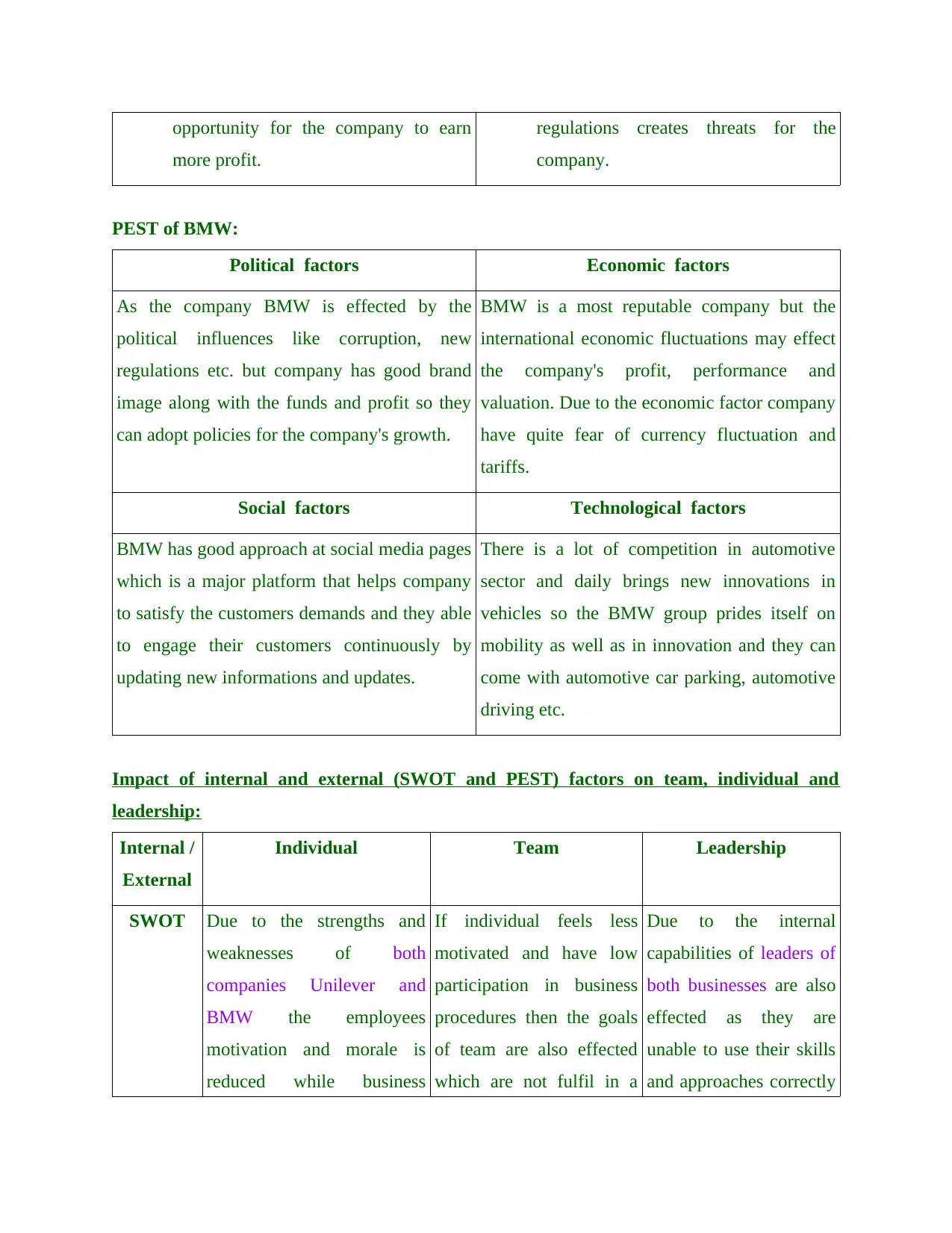
opportunity for the company to earn
more profit.
regulations creates threats for the
company.
PEST of BMW:
Political factors Economic factors
As the company BMW is effected by the
political influences like corruption, new
regulations etc. but company has good brand
image along with the funds and profit so they
can adopt policies for the company's growth.
BMW is a most reputable company but the
international economic fluctuations may effect
the company's profit, performance and
valuation. Due to the economic factor company
have quite fear of currency fluctuation and
tariffs.
Social factors Technological factors
BMW has good approach at social media pages
which is a major platform that helps company
to satisfy the customers demands and they able
to engage their customers continuously by
updating new informations and updates.
There is a lot of competition in automotive
sector and daily brings new innovations in
vehicles so the BMW group prides itself on
mobility as well as in innovation and they can
come with automotive car parking, automotive
driving etc.
Impact of internal and external (SWOT and PEST) factors on team, individual and
leadership:
Internal /
External
Individual Team Leadership
SWOT Due to the strengths and
weaknesses of both
companies Unilever and
BMW the employees
motivation and morale is
reduced while business
If individual feels less
motivated and have low
participation in business
procedures then the goals
of team are also effected
which are not fulfil in a
Due to the internal
capabilities of leaders of
both businesses are also
effected as they are
unable to use their skills
and approaches correctly
more profit.
regulations creates threats for the
company.
PEST of BMW:
Political factors Economic factors
As the company BMW is effected by the
political influences like corruption, new
regulations etc. but company has good brand
image along with the funds and profit so they
can adopt policies for the company's growth.
BMW is a most reputable company but the
international economic fluctuations may effect
the company's profit, performance and
valuation. Due to the economic factor company
have quite fear of currency fluctuation and
tariffs.
Social factors Technological factors
BMW has good approach at social media pages
which is a major platform that helps company
to satisfy the customers demands and they able
to engage their customers continuously by
updating new informations and updates.
There is a lot of competition in automotive
sector and daily brings new innovations in
vehicles so the BMW group prides itself on
mobility as well as in innovation and they can
come with automotive car parking, automotive
driving etc.
Impact of internal and external (SWOT and PEST) factors on team, individual and
leadership:
Internal /
External
Individual Team Leadership
SWOT Due to the strengths and
weaknesses of both
companies Unilever and
BMW the employees
motivation and morale is
reduced while business
If individual feels less
motivated and have low
participation in business
procedures then the goals
of team are also effected
which are not fulfil in a
Due to the internal
capabilities of leaders of
both businesses are also
effected as they are
unable to use their skills
and approaches correctly
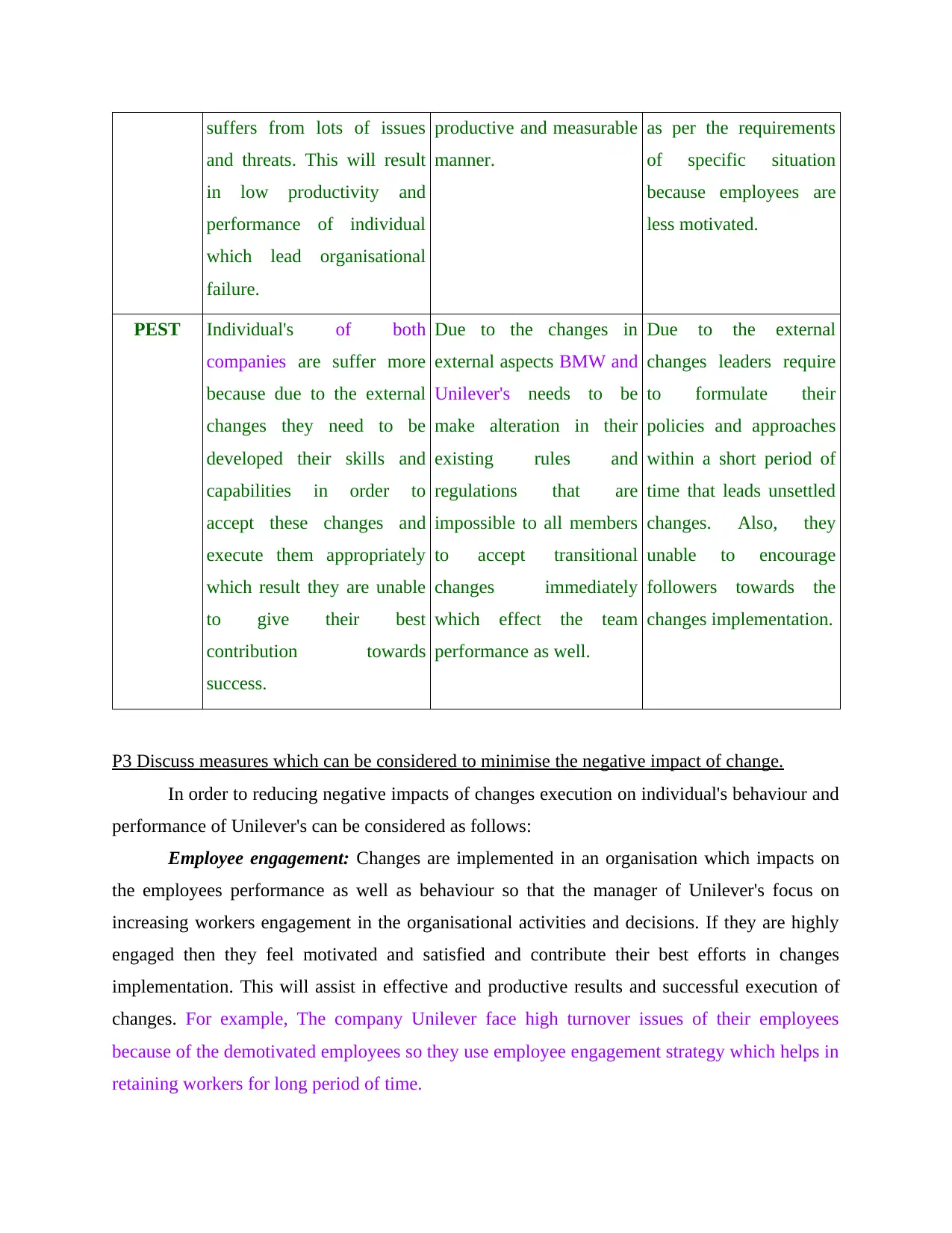
suffers from lots of issues
and threats. This will result
in low productivity and
performance of individual
which lead organisational
failure.
productive and measurable
manner.
as per the requirements
of specific situation
because employees are
less motivated.
PEST Individual's of both
companies are suffer more
because due to the external
changes they need to be
developed their skills and
capabilities in order to
accept these changes and
execute them appropriately
which result they are unable
to give their best
contribution towards
success.
Due to the changes in
external aspects BMW and
Unilever's needs to be
make alteration in their
existing rules and
regulations that are
impossible to all members
to accept transitional
changes immediately
which effect the team
performance as well.
Due to the external
changes leaders require
to formulate their
policies and approaches
within a short period of
time that leads unsettled
changes. Also, they
unable to encourage
followers towards the
changes implementation.
P3 Discuss measures which can be considered to minimise the negative impact of change.
In order to reducing negative impacts of changes execution on individual's behaviour and
performance of Unilever's can be considered as follows:
Employee engagement: Changes are implemented in an organisation which impacts on
the employees performance as well as behaviour so that the manager of Unilever's focus on
increasing workers engagement in the organisational activities and decisions. If they are highly
engaged then they feel motivated and satisfied and contribute their best efforts in changes
implementation. This will assist in effective and productive results and successful execution of
changes. For example, The company Unilever face high turnover issues of their employees
because of the demotivated employees so they use employee engagement strategy which helps in
retaining workers for long period of time.
and threats. This will result
in low productivity and
performance of individual
which lead organisational
failure.
productive and measurable
manner.
as per the requirements
of specific situation
because employees are
less motivated.
PEST Individual's of both
companies are suffer more
because due to the external
changes they need to be
developed their skills and
capabilities in order to
accept these changes and
execute them appropriately
which result they are unable
to give their best
contribution towards
success.
Due to the changes in
external aspects BMW and
Unilever's needs to be
make alteration in their
existing rules and
regulations that are
impossible to all members
to accept transitional
changes immediately
which effect the team
performance as well.
Due to the external
changes leaders require
to formulate their
policies and approaches
within a short period of
time that leads unsettled
changes. Also, they
unable to encourage
followers towards the
changes implementation.
P3 Discuss measures which can be considered to minimise the negative impact of change.
In order to reducing negative impacts of changes execution on individual's behaviour and
performance of Unilever's can be considered as follows:
Employee engagement: Changes are implemented in an organisation which impacts on
the employees performance as well as behaviour so that the manager of Unilever's focus on
increasing workers engagement in the organisational activities and decisions. If they are highly
engaged then they feel motivated and satisfied and contribute their best efforts in changes
implementation. This will assist in effective and productive results and successful execution of
changes. For example, The company Unilever face high turnover issues of their employees
because of the demotivated employees so they use employee engagement strategy which helps in
retaining workers for long period of time.

Effective communication: In order to minimise adverse impact Unilever's manger adopts
adequate mode of communication in order to interact with their workers for the purpose of
provide awareness about changes and its impacts. This will help in managing the changes
appropriately by getting members feedbacks and suggestions and accomplish organisational
objectives in an achievable manner (Dick, 2018). For instance, Unilever's Use direct
communication mode for interacting with their employees so that they knows clear situations and
issues and able to solve them on time.
Learning culture: As it is necessary for changes implementation as well as facilitate
better culture to the workers so that the behaviour and performance of them are influenced in a
positive way. The company Unilever focus on developing strong learning culture at their
workplace that will help in accomplishing better growth and success in near future. Also,
employees easily accept changes and ready to face all challenges happily. Also, leaders makes
effective use of their approaches to lead organisational changes positively and successfully. For
example, The management of company builds positive as well as learning culture at their
workplace so that their employees get to know about several new things in detail which gives
positive results to the company towards their growth and success.
M2 Critically evaluate how organisation responds towards change.
Burke Litwen model of organisational change is a framework that consists mainly four
element groups in a business which are represented in columns (Tang, 2019). The middle part of
this model considered as a backbone of model whereas, left side column called hard elements
that are measurable and tangible in nature and right side column known as soft elements that are
highly abstract.
adequate mode of communication in order to interact with their workers for the purpose of
provide awareness about changes and its impacts. This will help in managing the changes
appropriately by getting members feedbacks and suggestions and accomplish organisational
objectives in an achievable manner (Dick, 2018). For instance, Unilever's Use direct
communication mode for interacting with their employees so that they knows clear situations and
issues and able to solve them on time.
Learning culture: As it is necessary for changes implementation as well as facilitate
better culture to the workers so that the behaviour and performance of them are influenced in a
positive way. The company Unilever focus on developing strong learning culture at their
workplace that will help in accomplishing better growth and success in near future. Also,
employees easily accept changes and ready to face all challenges happily. Also, leaders makes
effective use of their approaches to lead organisational changes positively and successfully. For
example, The management of company builds positive as well as learning culture at their
workplace so that their employees get to know about several new things in detail which gives
positive results to the company towards their growth and success.
M2 Critically evaluate how organisation responds towards change.
Burke Litwen model of organisational change is a framework that consists mainly four
element groups in a business which are represented in columns (Tang, 2019). The middle part of
this model considered as a backbone of model whereas, left side column called hard elements
that are measurable and tangible in nature and right side column known as soft elements that are
highly abstract.
Paraphrase This Document
Need a fresh take? Get an instant paraphrase of this document with our AI Paraphraser
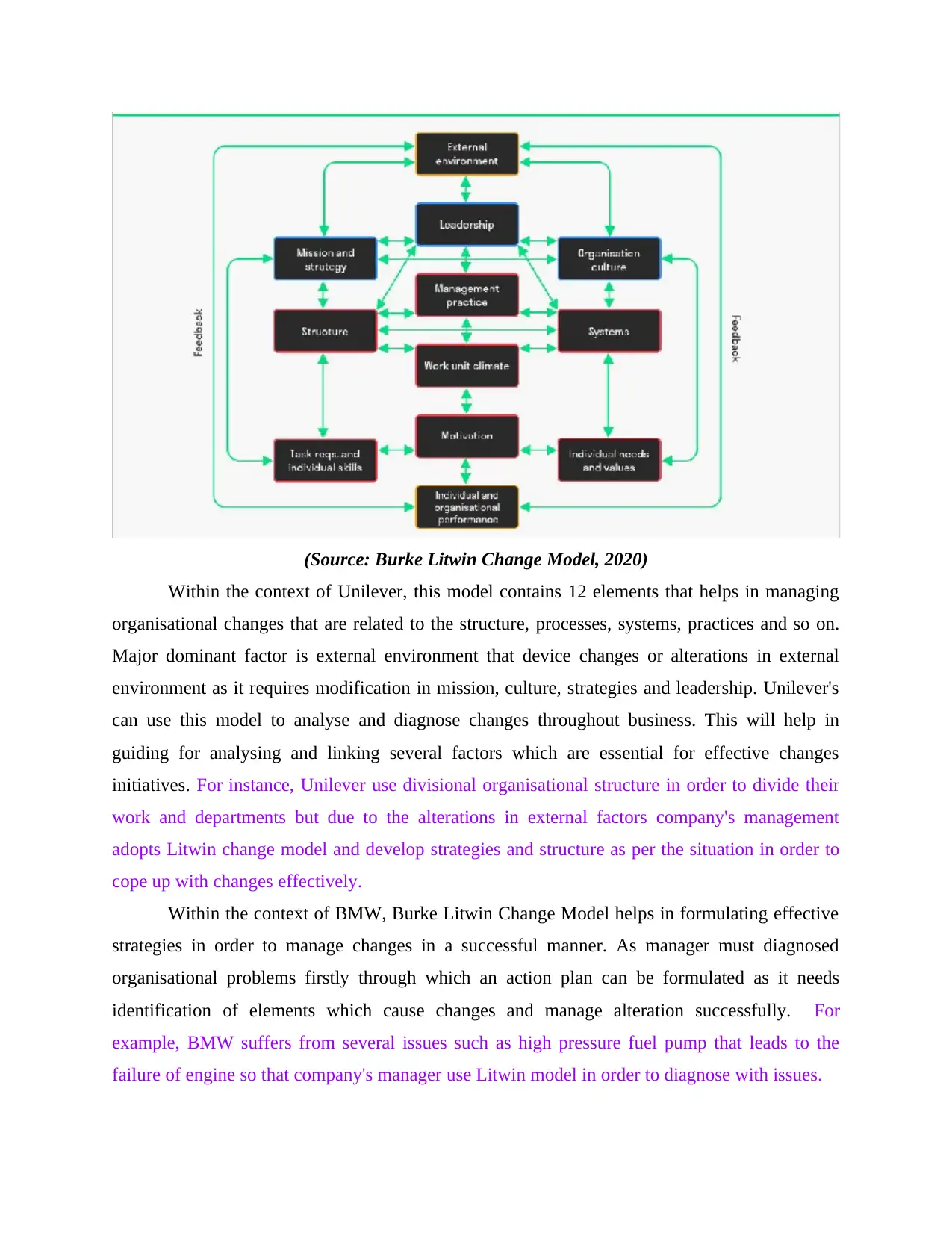
(Source: Burke Litwin Change Model, 2020)
Within the context of Unilever, this model contains 12 elements that helps in managing
organisational changes that are related to the structure, processes, systems, practices and so on.
Major dominant factor is external environment that device changes or alterations in external
environment as it requires modification in mission, culture, strategies and leadership. Unilever's
can use this model to analyse and diagnose changes throughout business. This will help in
guiding for analysing and linking several factors which are essential for effective changes
initiatives. For instance, Unilever use divisional organisational structure in order to divide their
work and departments but due to the alterations in external factors company's management
adopts Litwin change model and develop strategies and structure as per the situation in order to
cope up with changes effectively.
Within the context of BMW, Burke Litwin Change Model helps in formulating effective
strategies in order to manage changes in a successful manner. As manager must diagnosed
organisational problems firstly through which an action plan can be formulated as it needs
identification of elements which cause changes and manage alteration successfully. For
example, BMW suffers from several issues such as high pressure fuel pump that leads to the
failure of engine so that company's manager use Litwin model in order to diagnose with issues.
Within the context of Unilever, this model contains 12 elements that helps in managing
organisational changes that are related to the structure, processes, systems, practices and so on.
Major dominant factor is external environment that device changes or alterations in external
environment as it requires modification in mission, culture, strategies and leadership. Unilever's
can use this model to analyse and diagnose changes throughout business. This will help in
guiding for analysing and linking several factors which are essential for effective changes
initiatives. For instance, Unilever use divisional organisational structure in order to divide their
work and departments but due to the alterations in external factors company's management
adopts Litwin change model and develop strategies and structure as per the situation in order to
cope up with changes effectively.
Within the context of BMW, Burke Litwin Change Model helps in formulating effective
strategies in order to manage changes in a successful manner. As manager must diagnosed
organisational problems firstly through which an action plan can be formulated as it needs
identification of elements which cause changes and manage alteration successfully. For
example, BMW suffers from several issues such as high pressure fuel pump that leads to the
failure of engine so that company's manager use Litwin model in order to diagnose with issues.

D1 Conclusion and recommendations to planning for change.
The change impact analysis is created by Bohner & Armold that shows potential
impacts of changes and approximate what requires to be altered in order to successfully attain
changes (Cummings, 2016). It has been summarised from the above information that internal and
external change drivers leads organisational alterations in their processes, products, structure etc.
which required to be managed effectively for the long term survivability of business. The
manager of company have control over intrinsic drivers while extrinsic aspects results in
implementing changes in their existing policies and strategies. Successful execution of internal
changes and technological advancement helps Unilever's to get competitive advantages in the
market. Here, few recommendations for Unilever's for effective planning for changes are as
follows:
The company needs to adopt appropriate communicational modes in order to aware their
stakeholders regarding changes.
Manage the resistance, dependencies of change execution and budgeting risk also.
Unilever's should focus on participative management in order to engage their staff
members in a organisational activities and decisions.
TASK 3
P4 Change barriers and their influences on leadership decision-making.
According to the George R. Terry, leadership refers to the relationships among leaders
and followers in which an individual or leader influence the behaviour of others in order to work
together and achieve tasks willingly (Leadership, 2020).
While a company Unilever's adopts and implement changes in their strategies, processes
and products or services then several barriers they faced which impacts on their decision making
process (Cameron, 2019). So the management of company need to know about those challenges
in order to be dealt properly by implementing effective changes. Some barriers are discussed as
follows: Lack of participation: The company suffers from less contribution and involvement of
employees in organisational changes and decisions. So manager of Unilever's puts high
efforts for employee participation so as the embrace feeling of individual's could be
The change impact analysis is created by Bohner & Armold that shows potential
impacts of changes and approximate what requires to be altered in order to successfully attain
changes (Cummings, 2016). It has been summarised from the above information that internal and
external change drivers leads organisational alterations in their processes, products, structure etc.
which required to be managed effectively for the long term survivability of business. The
manager of company have control over intrinsic drivers while extrinsic aspects results in
implementing changes in their existing policies and strategies. Successful execution of internal
changes and technological advancement helps Unilever's to get competitive advantages in the
market. Here, few recommendations for Unilever's for effective planning for changes are as
follows:
The company needs to adopt appropriate communicational modes in order to aware their
stakeholders regarding changes.
Manage the resistance, dependencies of change execution and budgeting risk also.
Unilever's should focus on participative management in order to engage their staff
members in a organisational activities and decisions.
TASK 3
P4 Change barriers and their influences on leadership decision-making.
According to the George R. Terry, leadership refers to the relationships among leaders
and followers in which an individual or leader influence the behaviour of others in order to work
together and achieve tasks willingly (Leadership, 2020).
While a company Unilever's adopts and implement changes in their strategies, processes
and products or services then several barriers they faced which impacts on their decision making
process (Cameron, 2019). So the management of company need to know about those challenges
in order to be dealt properly by implementing effective changes. Some barriers are discussed as
follows: Lack of participation: The company suffers from less contribution and involvement of
employees in organisational changes and decisions. So manager of Unilever's puts high
efforts for employee participation so as the embrace feeling of individual's could be
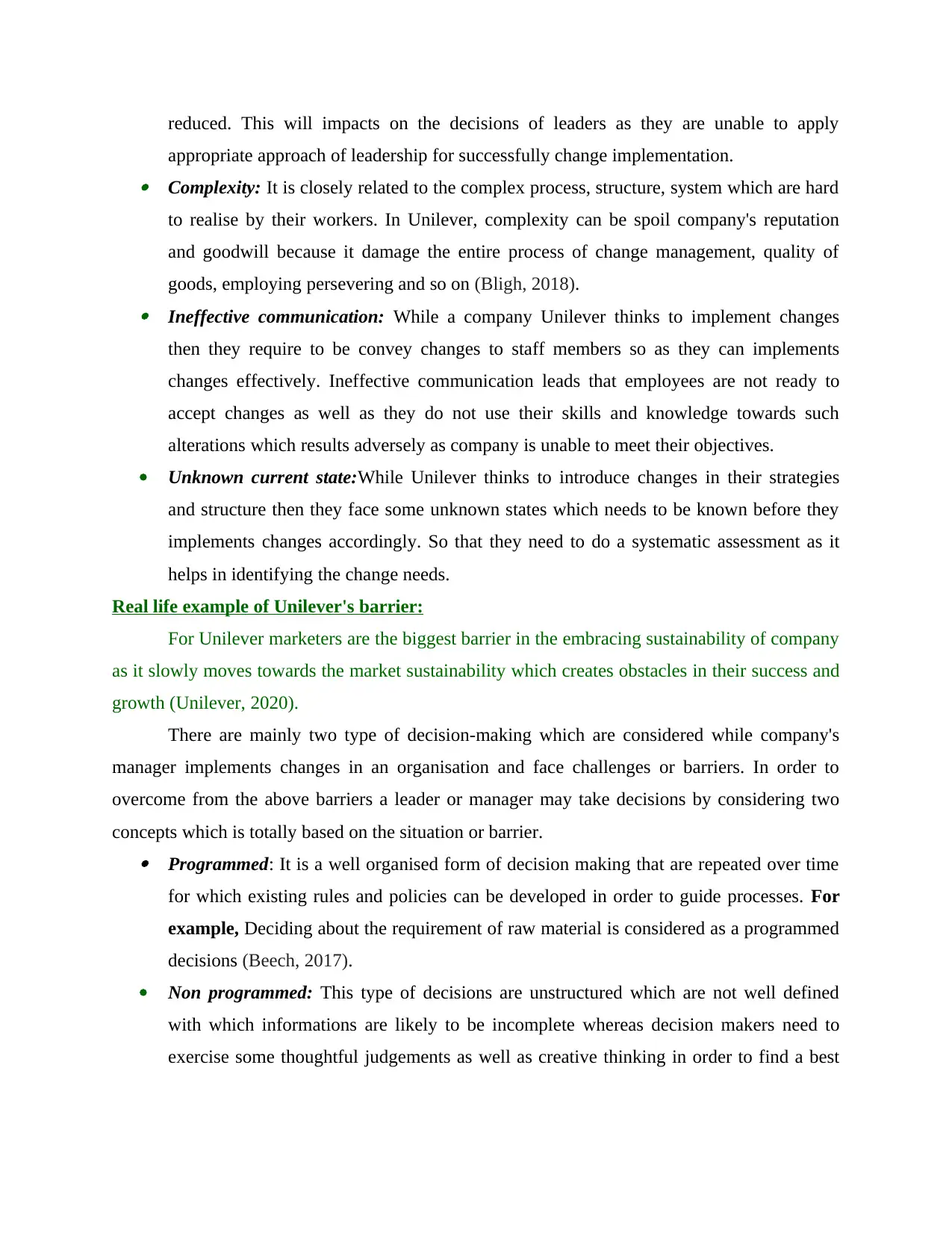
reduced. This will impacts on the decisions of leaders as they are unable to apply
appropriate approach of leadership for successfully change implementation. Complexity: It is closely related to the complex process, structure, system which are hard
to realise by their workers. In Unilever, complexity can be spoil company's reputation
and goodwill because it damage the entire process of change management, quality of
goods, employing persevering and so on (Bligh, 2018). Ineffective communication: While a company Unilever thinks to implement changes
then they require to be convey changes to staff members so as they can implements
changes effectively. Ineffective communication leads that employees are not ready to
accept changes as well as they do not use their skills and knowledge towards such
alterations which results adversely as company is unable to meet their objectives.
Unknown current state:While Unilever thinks to introduce changes in their strategies
and structure then they face some unknown states which needs to be known before they
implements changes accordingly. So that they need to do a systematic assessment as it
helps in identifying the change needs.
Real life example of Unilever's barrier:
For Unilever marketers are the biggest barrier in the embracing sustainability of company
as it slowly moves towards the market sustainability which creates obstacles in their success and
growth (Unilever, 2020).
There are mainly two type of decision-making which are considered while company's
manager implements changes in an organisation and face challenges or barriers. In order to
overcome from the above barriers a leader or manager may take decisions by considering two
concepts which is totally based on the situation or barrier. Programmed: It is a well organised form of decision making that are repeated over time
for which existing rules and policies can be developed in order to guide processes. For
example, Deciding about the requirement of raw material is considered as a programmed
decisions (Beech, 2017).
Non programmed: This type of decisions are unstructured which are not well defined
with which informations are likely to be incomplete whereas decision makers need to
exercise some thoughtful judgements as well as creative thinking in order to find a best
appropriate approach of leadership for successfully change implementation. Complexity: It is closely related to the complex process, structure, system which are hard
to realise by their workers. In Unilever, complexity can be spoil company's reputation
and goodwill because it damage the entire process of change management, quality of
goods, employing persevering and so on (Bligh, 2018). Ineffective communication: While a company Unilever thinks to implement changes
then they require to be convey changes to staff members so as they can implements
changes effectively. Ineffective communication leads that employees are not ready to
accept changes as well as they do not use their skills and knowledge towards such
alterations which results adversely as company is unable to meet their objectives.
Unknown current state:While Unilever thinks to introduce changes in their strategies
and structure then they face some unknown states which needs to be known before they
implements changes accordingly. So that they need to do a systematic assessment as it
helps in identifying the change needs.
Real life example of Unilever's barrier:
For Unilever marketers are the biggest barrier in the embracing sustainability of company
as it slowly moves towards the market sustainability which creates obstacles in their success and
growth (Unilever, 2020).
There are mainly two type of decision-making which are considered while company's
manager implements changes in an organisation and face challenges or barriers. In order to
overcome from the above barriers a leader or manager may take decisions by considering two
concepts which is totally based on the situation or barrier. Programmed: It is a well organised form of decision making that are repeated over time
for which existing rules and policies can be developed in order to guide processes. For
example, Deciding about the requirement of raw material is considered as a programmed
decisions (Beech, 2017).
Non programmed: This type of decisions are unstructured which are not well defined
with which informations are likely to be incomplete whereas decision makers need to
exercise some thoughtful judgements as well as creative thinking in order to find a best
Secure Best Marks with AI Grader
Need help grading? Try our AI Grader for instant feedback on your assignments.
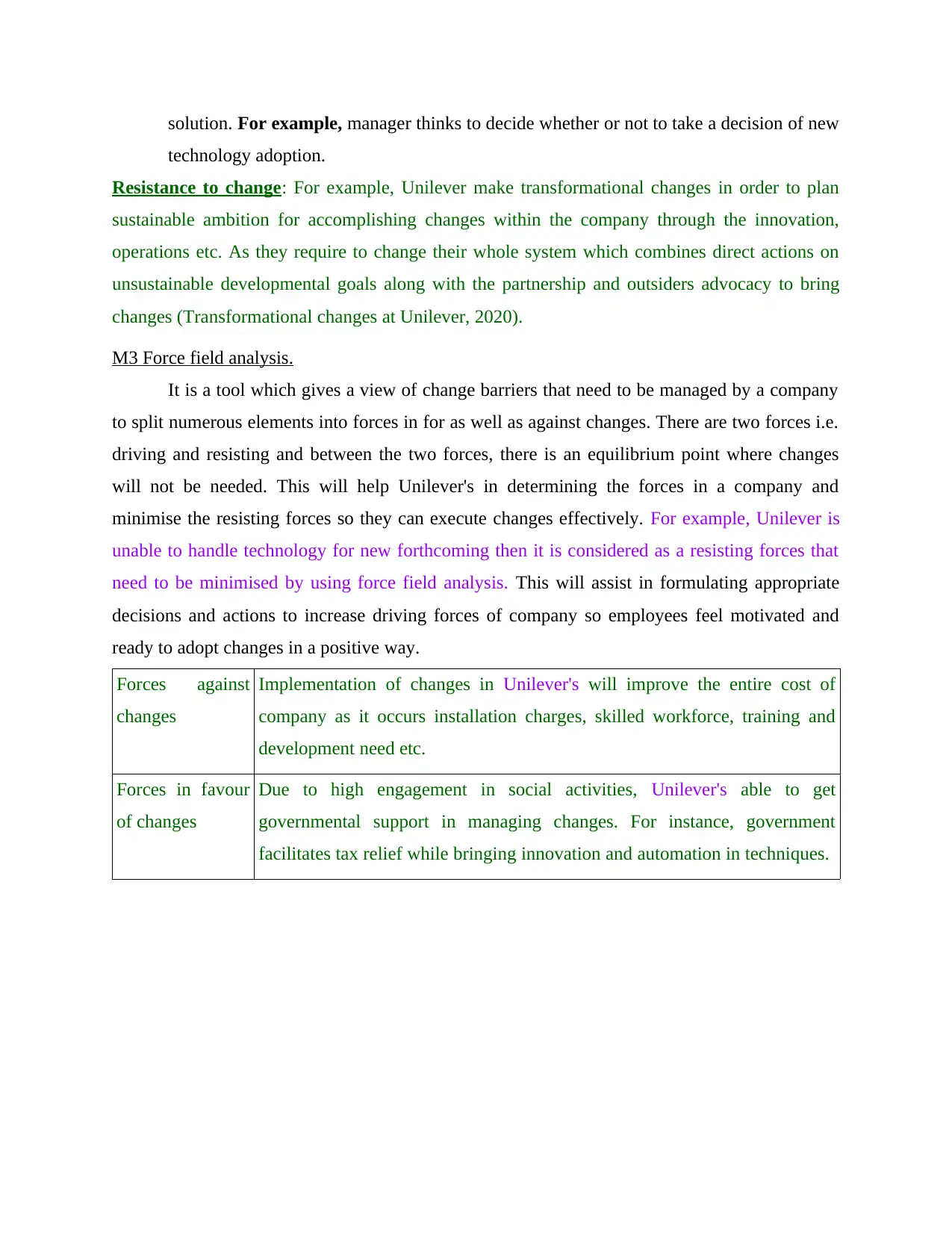
solution. For example, manager thinks to decide whether or not to take a decision of new
technology adoption.
Resistance to change: For example, Unilever make transformational changes in order to plan
sustainable ambition for accomplishing changes within the company through the innovation,
operations etc. As they require to change their whole system which combines direct actions on
unsustainable developmental goals along with the partnership and outsiders advocacy to bring
changes (Transformational changes at Unilever, 2020).
M3 Force field analysis.
It is a tool which gives a view of change barriers that need to be managed by a company
to split numerous elements into forces in for as well as against changes. There are two forces i.e.
driving and resisting and between the two forces, there is an equilibrium point where changes
will not be needed. This will help Unilever's in determining the forces in a company and
minimise the resisting forces so they can execute changes effectively. For example, Unilever is
unable to handle technology for new forthcoming then it is considered as a resisting forces that
need to be minimised by using force field analysis. This will assist in formulating appropriate
decisions and actions to increase driving forces of company so employees feel motivated and
ready to adopt changes in a positive way.
Forces against
changes
Implementation of changes in Unilever's will improve the entire cost of
company as it occurs installation charges, skilled workforce, training and
development need etc.
Forces in favour
of changes
Due to high engagement in social activities, Unilever's able to get
governmental support in managing changes. For instance, government
facilitates tax relief while bringing innovation and automation in techniques.
technology adoption.
Resistance to change: For example, Unilever make transformational changes in order to plan
sustainable ambition for accomplishing changes within the company through the innovation,
operations etc. As they require to change their whole system which combines direct actions on
unsustainable developmental goals along with the partnership and outsiders advocacy to bring
changes (Transformational changes at Unilever, 2020).
M3 Force field analysis.
It is a tool which gives a view of change barriers that need to be managed by a company
to split numerous elements into forces in for as well as against changes. There are two forces i.e.
driving and resisting and between the two forces, there is an equilibrium point where changes
will not be needed. This will help Unilever's in determining the forces in a company and
minimise the resisting forces so they can execute changes effectively. For example, Unilever is
unable to handle technology for new forthcoming then it is considered as a resisting forces that
need to be minimised by using force field analysis. This will assist in formulating appropriate
decisions and actions to increase driving forces of company so employees feel motivated and
ready to adopt changes in a positive way.
Forces against
changes
Implementation of changes in Unilever's will improve the entire cost of
company as it occurs installation charges, skilled workforce, training and
development need etc.
Forces in favour
of changes
Due to high engagement in social activities, Unilever's able to get
governmental support in managing changes. For instance, government
facilitates tax relief while bringing innovation and automation in techniques.
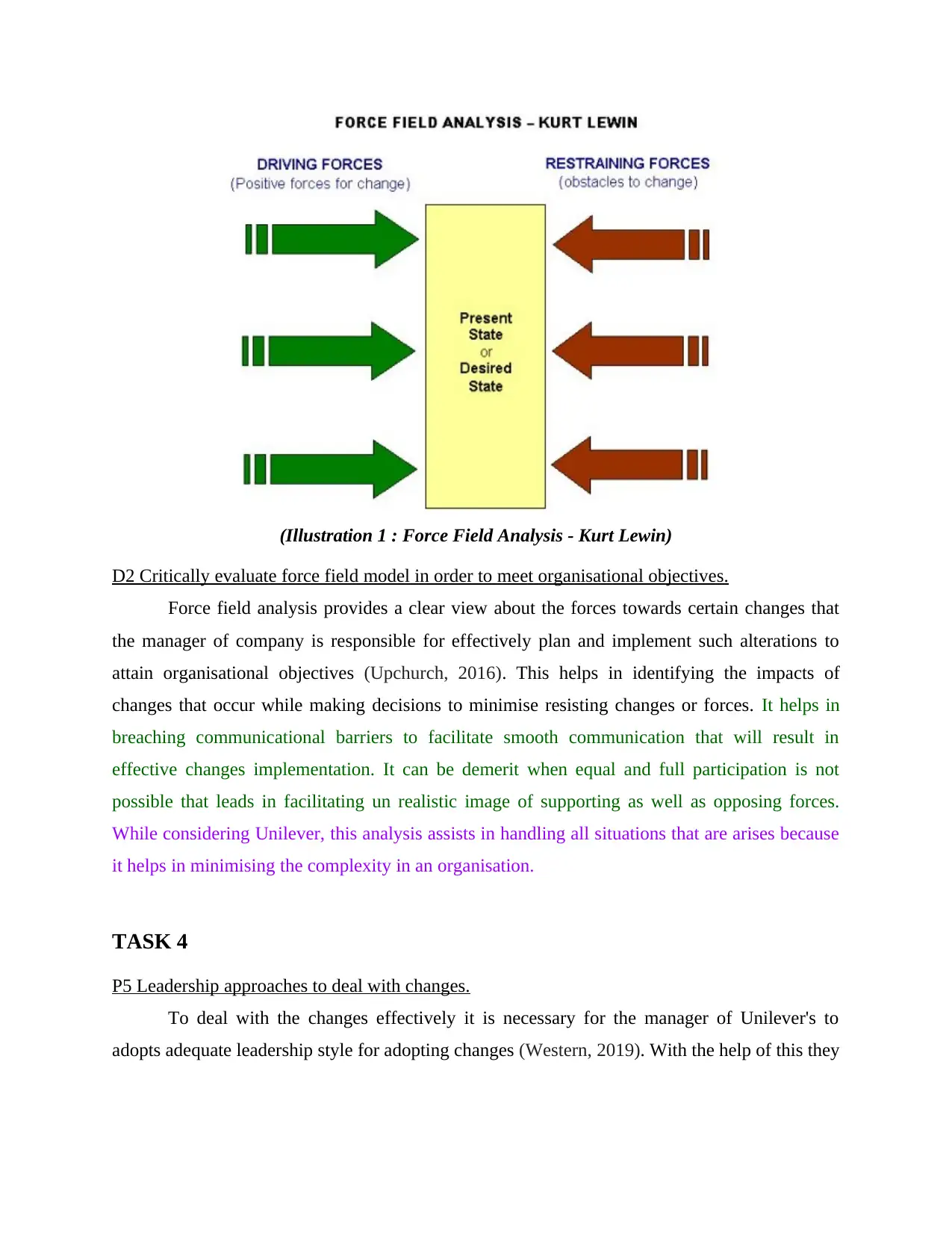
(Illustration 1 : Force Field Analysis - Kurt Lewin)
D2 Critically evaluate force field model in order to meet organisational objectives.
Force field analysis provides a clear view about the forces towards certain changes that
the manager of company is responsible for effectively plan and implement such alterations to
attain organisational objectives (Upchurch, 2016). This helps in identifying the impacts of
changes that occur while making decisions to minimise resisting changes or forces. It helps in
breaching communicational barriers to facilitate smooth communication that will result in
effective changes implementation. It can be demerit when equal and full participation is not
possible that leads in facilitating un realistic image of supporting as well as opposing forces.
While considering Unilever, this analysis assists in handling all situations that are arises because
it helps in minimising the complexity in an organisation.
TASK 4
P5 Leadership approaches to deal with changes.
To deal with the changes effectively it is necessary for the manager of Unilever's to
adopts adequate leadership style for adopting changes (Western, 2019). With the help of this they
D2 Critically evaluate force field model in order to meet organisational objectives.
Force field analysis provides a clear view about the forces towards certain changes that
the manager of company is responsible for effectively plan and implement such alterations to
attain organisational objectives (Upchurch, 2016). This helps in identifying the impacts of
changes that occur while making decisions to minimise resisting changes or forces. It helps in
breaching communicational barriers to facilitate smooth communication that will result in
effective changes implementation. It can be demerit when equal and full participation is not
possible that leads in facilitating un realistic image of supporting as well as opposing forces.
While considering Unilever, this analysis assists in handling all situations that are arises because
it helps in minimising the complexity in an organisation.
TASK 4
P5 Leadership approaches to deal with changes.
To deal with the changes effectively it is necessary for the manager of Unilever's to
adopts adequate leadership style for adopting changes (Western, 2019). With the help of this they

can able to motivate and encourage their staff members and ensures the success of changes
implementation. There are several leadership approaches that are as follows:
Situational leadership: It is considered as a most appropriate leadership style that assists
an organisation to deal with the varied range of situations. The leader or manager of Unilever's
can use this kind of leadership approach for successfully adopts changes in against to react on
immediate situations which will occurs randomly and continuously. It is termed as a flexible
approach as it helps in dealing with varied situations or issues (Schedlitzki, 2017). Whereas, it is
ineffective also in some situations like it is inappropriate for task oriented environment because it
emphasised on the immediate problems instead of long term objectives and goals.
Autocratic style: It is related to the centralised and under controlled approach in which all
activities and decisions are controlled by the single person or can consider that manager can
accept low inputs from their workers. As Unilever's manager can use autocratic leadership
approach for creating learning culture for staff members towards the changes and they do not act
on the basis of followers or workers reactions. Moreover, it is inappropriate in some situations as
the entire load of working is only on the manager that creates some kind of health issues like
stress and mental diseases (Alavi, 2017).
Democratic leadership: It is directly influenced with the participative management as it
is related to the employees involvement and engagement in organisational decisions as well as
activities. The manager of Unilever's can use democratic style to lead changes by creating and
maintaining positive as well as strong relations with them. In addition, it is ineffective also as it
requires huge time to communicate personally with all and consider all suggestions and opinions
towards a single issue so this might be creates the feeling of dissatisfaction and arises conflicts.
M4 Evaluate how leadership approach can deliver organisational changes effectively.
Manager of Unilever's use Lewin change management model at their working
environment that assists in implementing successful changes as well as helps in analysing the
needs of changes in respective policies, strategies and structure. It is divided into three category
such as unfreezing which means company can need to initiates changes and implements by
involving their motivated employee’s. After that, change includes that manager of Unilever's can
focus on alteration with which they can use appropriate leadership style and effectively
communicate with individual and team (Akpoviroro, 2018). Lastly, refreezing means
successfully do changes that has been implemented by their employees in order to get advantage
implementation. There are several leadership approaches that are as follows:
Situational leadership: It is considered as a most appropriate leadership style that assists
an organisation to deal with the varied range of situations. The leader or manager of Unilever's
can use this kind of leadership approach for successfully adopts changes in against to react on
immediate situations which will occurs randomly and continuously. It is termed as a flexible
approach as it helps in dealing with varied situations or issues (Schedlitzki, 2017). Whereas, it is
ineffective also in some situations like it is inappropriate for task oriented environment because it
emphasised on the immediate problems instead of long term objectives and goals.
Autocratic style: It is related to the centralised and under controlled approach in which all
activities and decisions are controlled by the single person or can consider that manager can
accept low inputs from their workers. As Unilever's manager can use autocratic leadership
approach for creating learning culture for staff members towards the changes and they do not act
on the basis of followers or workers reactions. Moreover, it is inappropriate in some situations as
the entire load of working is only on the manager that creates some kind of health issues like
stress and mental diseases (Alavi, 2017).
Democratic leadership: It is directly influenced with the participative management as it
is related to the employees involvement and engagement in organisational decisions as well as
activities. The manager of Unilever's can use democratic style to lead changes by creating and
maintaining positive as well as strong relations with them. In addition, it is ineffective also as it
requires huge time to communicate personally with all and consider all suggestions and opinions
towards a single issue so this might be creates the feeling of dissatisfaction and arises conflicts.
M4 Evaluate how leadership approach can deliver organisational changes effectively.
Manager of Unilever's use Lewin change management model at their working
environment that assists in implementing successful changes as well as helps in analysing the
needs of changes in respective policies, strategies and structure. It is divided into three category
such as unfreezing which means company can need to initiates changes and implements by
involving their motivated employee’s. After that, change includes that manager of Unilever's can
focus on alteration with which they can use appropriate leadership style and effectively
communicate with individual and team (Akpoviroro, 2018). Lastly, refreezing means
successfully do changes that has been implemented by their employees in order to get advantage
Paraphrase This Document
Need a fresh take? Get an instant paraphrase of this document with our AI Paraphraser
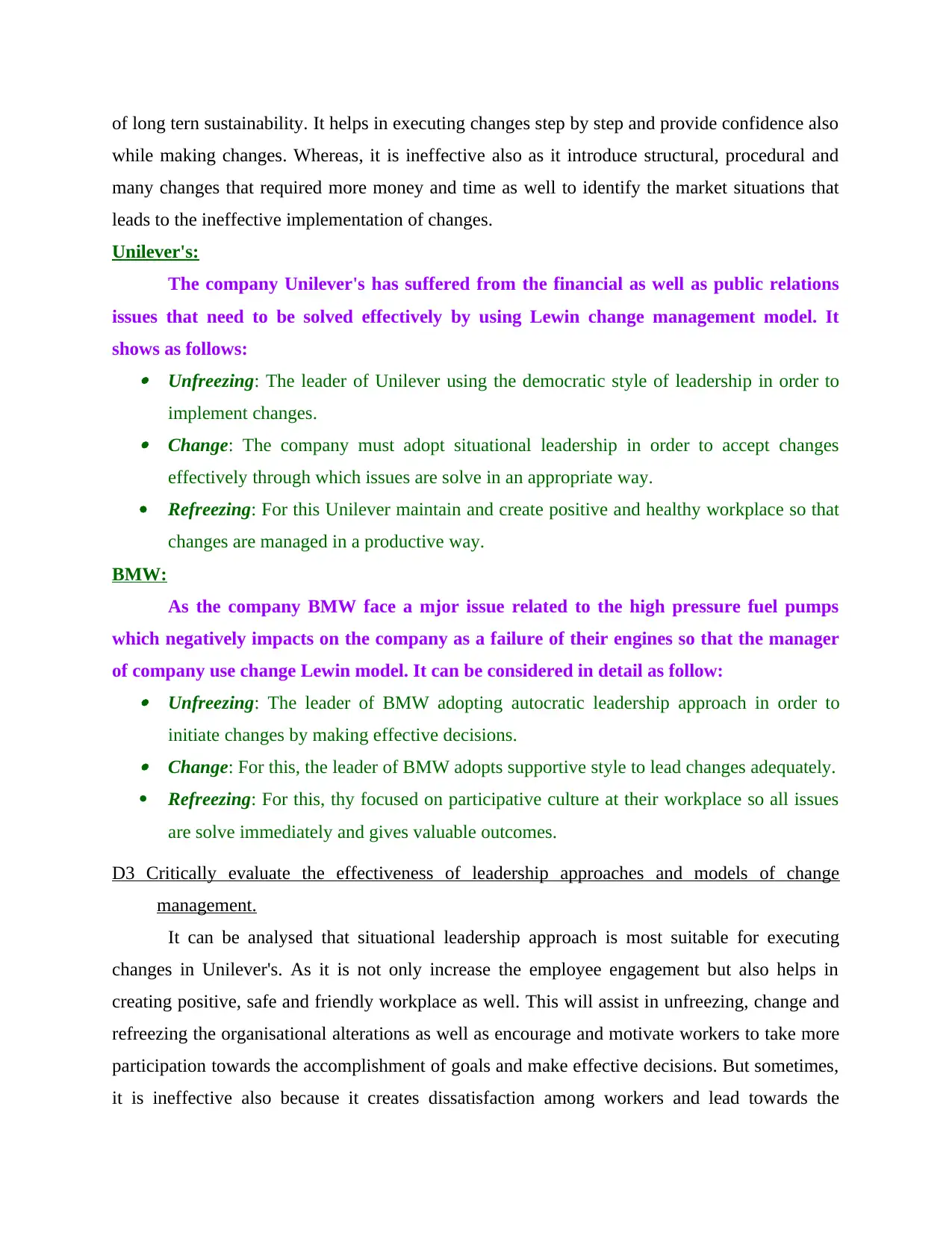
of long tern sustainability. It helps in executing changes step by step and provide confidence also
while making changes. Whereas, it is ineffective also as it introduce structural, procedural and
many changes that required more money and time as well to identify the market situations that
leads to the ineffective implementation of changes.
Unilever's:
The company Unilever's has suffered from the financial as well as public relations
issues that need to be solved effectively by using Lewin change management model. It
shows as follows: Unfreezing: The leader of Unilever using the democratic style of leadership in order to
implement changes. Change: The company must adopt situational leadership in order to accept changes
effectively through which issues are solve in an appropriate way.
Refreezing: For this Unilever maintain and create positive and healthy workplace so that
changes are managed in a productive way.
BMW:
As the company BMW face a mjor issue related to the high pressure fuel pumps
which negatively impacts on the company as a failure of their engines so that the manager
of company use change Lewin model. It can be considered in detail as follow: Unfreezing: The leader of BMW adopting autocratic leadership approach in order to
initiate changes by making effective decisions. Change: For this, the leader of BMW adopts supportive style to lead changes adequately.
Refreezing: For this, thy focused on participative culture at their workplace so all issues
are solve immediately and gives valuable outcomes.
D3 Critically evaluate the effectiveness of leadership approaches and models of change
management.
It can be analysed that situational leadership approach is most suitable for executing
changes in Unilever's. As it is not only increase the employee engagement but also helps in
creating positive, safe and friendly workplace as well. This will assist in unfreezing, change and
refreezing the organisational alterations as well as encourage and motivate workers to take more
participation towards the accomplishment of goals and make effective decisions. But sometimes,
it is ineffective also because it creates dissatisfaction among workers and lead towards the
while making changes. Whereas, it is ineffective also as it introduce structural, procedural and
many changes that required more money and time as well to identify the market situations that
leads to the ineffective implementation of changes.
Unilever's:
The company Unilever's has suffered from the financial as well as public relations
issues that need to be solved effectively by using Lewin change management model. It
shows as follows: Unfreezing: The leader of Unilever using the democratic style of leadership in order to
implement changes. Change: The company must adopt situational leadership in order to accept changes
effectively through which issues are solve in an appropriate way.
Refreezing: For this Unilever maintain and create positive and healthy workplace so that
changes are managed in a productive way.
BMW:
As the company BMW face a mjor issue related to the high pressure fuel pumps
which negatively impacts on the company as a failure of their engines so that the manager
of company use change Lewin model. It can be considered in detail as follow: Unfreezing: The leader of BMW adopting autocratic leadership approach in order to
initiate changes by making effective decisions. Change: For this, the leader of BMW adopts supportive style to lead changes adequately.
Refreezing: For this, thy focused on participative culture at their workplace so all issues
are solve immediately and gives valuable outcomes.
D3 Critically evaluate the effectiveness of leadership approaches and models of change
management.
It can be analysed that situational leadership approach is most suitable for executing
changes in Unilever's. As it is not only increase the employee engagement but also helps in
creating positive, safe and friendly workplace as well. This will assist in unfreezing, change and
refreezing the organisational alterations as well as encourage and motivate workers to take more
participation towards the accomplishment of goals and make effective decisions. But sometimes,
it is ineffective also because it creates dissatisfaction among workers and lead towards the
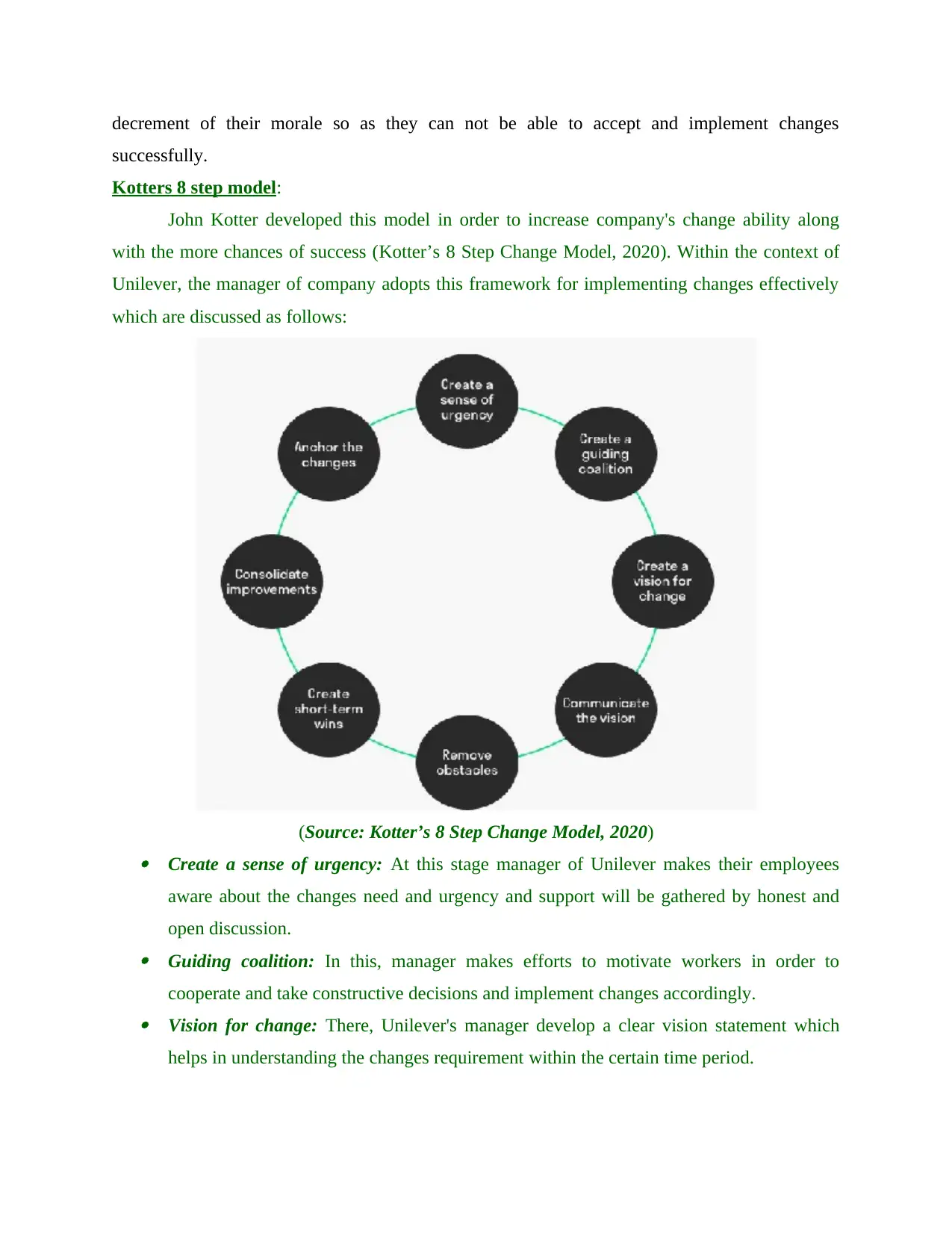
decrement of their morale so as they can not be able to accept and implement changes
successfully.
Kotters 8 step model:
John Kotter developed this model in order to increase company's change ability along
with the more chances of success (Kotter’s 8 Step Change Model, 2020). Within the context of
Unilever, the manager of company adopts this framework for implementing changes effectively
which are discussed as follows:
(Source: Kotter’s 8 Step Change Model, 2020) Create a sense of urgency: At this stage manager of Unilever makes their employees
aware about the changes need and urgency and support will be gathered by honest and
open discussion. Guiding coalition: In this, manager makes efforts to motivate workers in order to
cooperate and take constructive decisions and implement changes accordingly. Vision for change: There, Unilever's manager develop a clear vision statement which
helps in understanding the changes requirement within the certain time period.
successfully.
Kotters 8 step model:
John Kotter developed this model in order to increase company's change ability along
with the more chances of success (Kotter’s 8 Step Change Model, 2020). Within the context of
Unilever, the manager of company adopts this framework for implementing changes effectively
which are discussed as follows:
(Source: Kotter’s 8 Step Change Model, 2020) Create a sense of urgency: At this stage manager of Unilever makes their employees
aware about the changes need and urgency and support will be gathered by honest and
open discussion. Guiding coalition: In this, manager makes efforts to motivate workers in order to
cooperate and take constructive decisions and implement changes accordingly. Vision for change: There, Unilever's manager develop a clear vision statement which
helps in understanding the changes requirement within the certain time period.
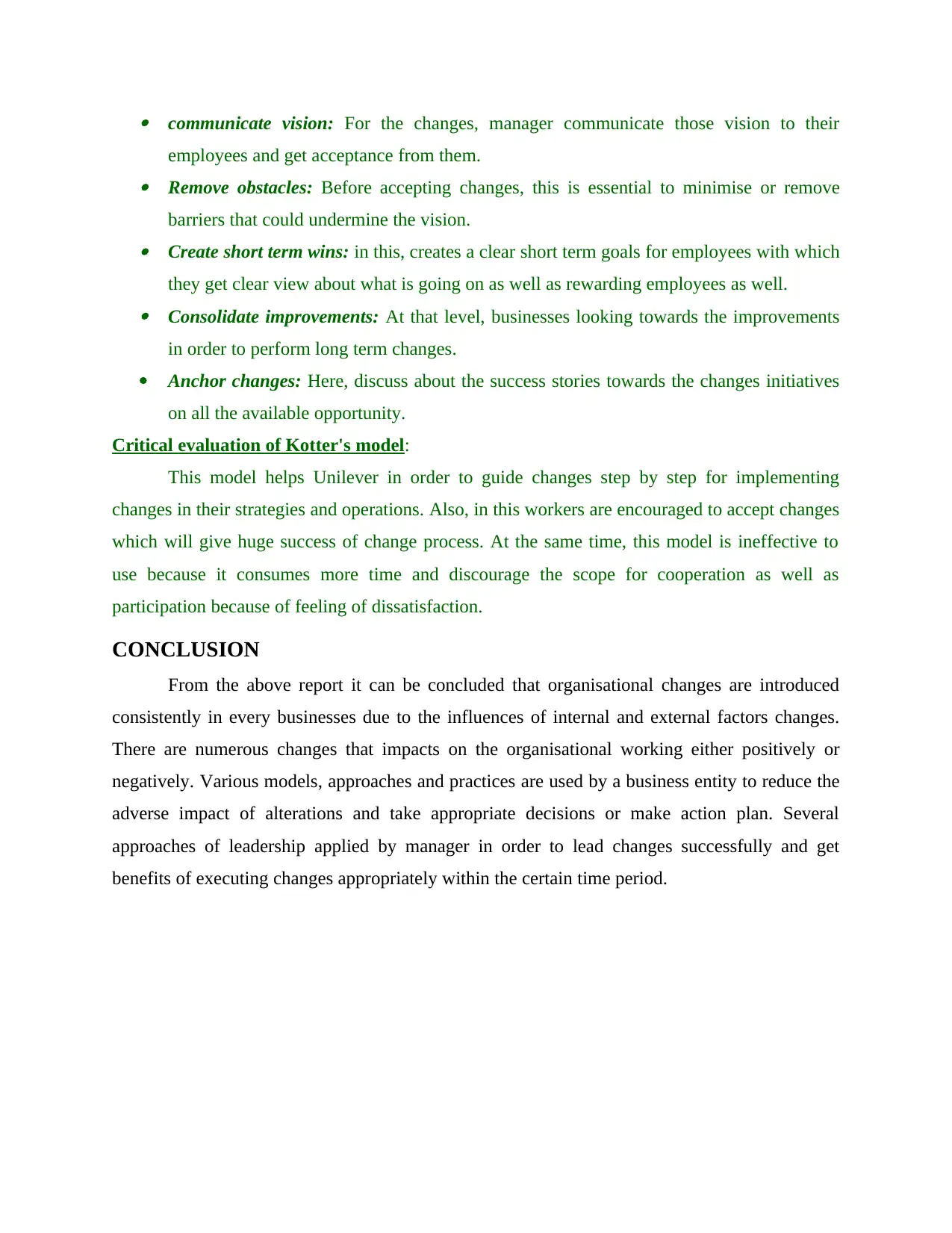
communicate vision: For the changes, manager communicate those vision to their
employees and get acceptance from them. Remove obstacles: Before accepting changes, this is essential to minimise or remove
barriers that could undermine the vision. Create short term wins: in this, creates a clear short term goals for employees with which
they get clear view about what is going on as well as rewarding employees as well. Consolidate improvements: At that level, businesses looking towards the improvements
in order to perform long term changes.
Anchor changes: Here, discuss about the success stories towards the changes initiatives
on all the available opportunity.
Critical evaluation of Kotter's model:
This model helps Unilever in order to guide changes step by step for implementing
changes in their strategies and operations. Also, in this workers are encouraged to accept changes
which will give huge success of change process. At the same time, this model is ineffective to
use because it consumes more time and discourage the scope for cooperation as well as
participation because of feeling of dissatisfaction.
CONCLUSION
From the above report it can be concluded that organisational changes are introduced
consistently in every businesses due to the influences of internal and external factors changes.
There are numerous changes that impacts on the organisational working either positively or
negatively. Various models, approaches and practices are used by a business entity to reduce the
adverse impact of alterations and take appropriate decisions or make action plan. Several
approaches of leadership applied by manager in order to lead changes successfully and get
benefits of executing changes appropriately within the certain time period.
employees and get acceptance from them. Remove obstacles: Before accepting changes, this is essential to minimise or remove
barriers that could undermine the vision. Create short term wins: in this, creates a clear short term goals for employees with which
they get clear view about what is going on as well as rewarding employees as well. Consolidate improvements: At that level, businesses looking towards the improvements
in order to perform long term changes.
Anchor changes: Here, discuss about the success stories towards the changes initiatives
on all the available opportunity.
Critical evaluation of Kotter's model:
This model helps Unilever in order to guide changes step by step for implementing
changes in their strategies and operations. Also, in this workers are encouraged to accept changes
which will give huge success of change process. At the same time, this model is ineffective to
use because it consumes more time and discourage the scope for cooperation as well as
participation because of feeling of dissatisfaction.
CONCLUSION
From the above report it can be concluded that organisational changes are introduced
consistently in every businesses due to the influences of internal and external factors changes.
There are numerous changes that impacts on the organisational working either positively or
negatively. Various models, approaches and practices are used by a business entity to reduce the
adverse impact of alterations and take appropriate decisions or make action plan. Several
approaches of leadership applied by manager in order to lead changes successfully and get
benefits of executing changes appropriately within the certain time period.
Secure Best Marks with AI Grader
Need help grading? Try our AI Grader for instant feedback on your assignments.
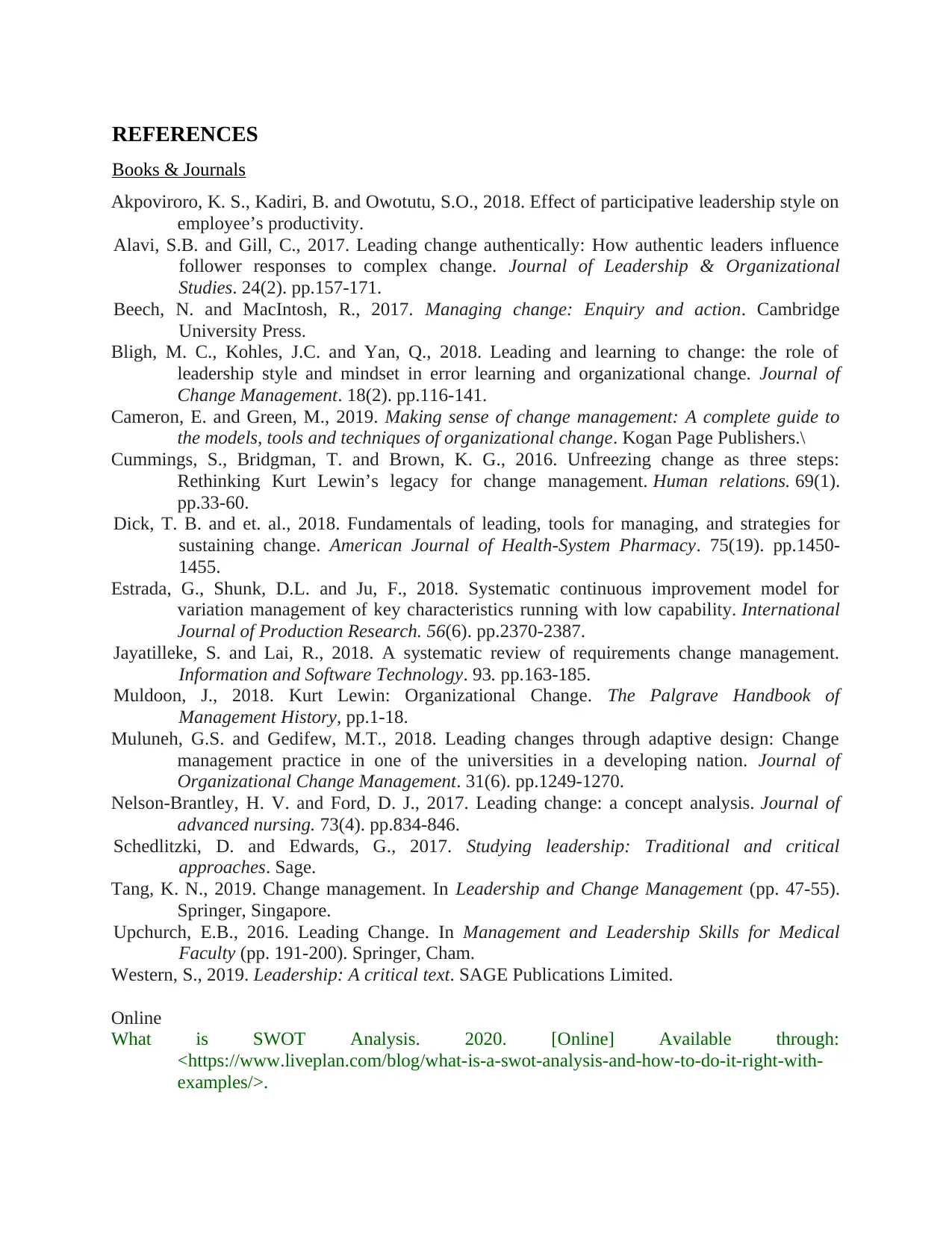
REFERENCES
Books & Journals
Akpoviroro, K. S., Kadiri, B. and Owotutu, S.O., 2018. Effect of participative leadership style on
employee’s productivity.
Alavi, S.B. and Gill, C., 2017. Leading change authentically: How authentic leaders influence
follower responses to complex change. Journal of Leadership & Organizational
Studies. 24(2). pp.157-171.
Beech, N. and MacIntosh, R., 2017. Managing change: Enquiry and action. Cambridge
University Press.
Bligh, M. C., Kohles, J.C. and Yan, Q., 2018. Leading and learning to change: the role of
leadership style and mindset in error learning and organizational change. Journal of
Change Management. 18(2). pp.116-141.
Cameron, E. and Green, M., 2019. Making sense of change management: A complete guide to
the models, tools and techniques of organizational change. Kogan Page Publishers.\
Cummings, S., Bridgman, T. and Brown, K. G., 2016. Unfreezing change as three steps:
Rethinking Kurt Lewin’s legacy for change management. Human relations. 69(1).
pp.33-60.
Dick, T. B. and et. al., 2018. Fundamentals of leading, tools for managing, and strategies for
sustaining change. American Journal of Health-System Pharmacy. 75(19). pp.1450-
1455.
Estrada, G., Shunk, D.L. and Ju, F., 2018. Systematic continuous improvement model for
variation management of key characteristics running with low capability. International
Journal of Production Research. 56(6). pp.2370-2387.
Jayatilleke, S. and Lai, R., 2018. A systematic review of requirements change management.
Information and Software Technology. 93. pp.163-185.
Muldoon, J., 2018. Kurt Lewin: Organizational Change. The Palgrave Handbook of
Management History, pp.1-18.
Muluneh, G.S. and Gedifew, M.T., 2018. Leading changes through adaptive design: Change
management practice in one of the universities in a developing nation. Journal of
Organizational Change Management. 31(6). pp.1249-1270.
Nelson‐Brantley, H. V. and Ford, D. J., 2017. Leading change: a concept analysis. Journal of
advanced nursing. 73(4). pp.834-846.
Schedlitzki, D. and Edwards, G., 2017. Studying leadership: Traditional and critical
approaches. Sage.
Tang, K. N., 2019. Change management. In Leadership and Change Management (pp. 47-55).
Springer, Singapore.
Upchurch, E.B., 2016. Leading Change. In Management and Leadership Skills for Medical
Faculty (pp. 191-200). Springer, Cham.
Western, S., 2019. Leadership: A critical text. SAGE Publications Limited.
Online
What is SWOT Analysis. 2020. [Online] Available through:
<https://www.liveplan.com/blog/what-is-a-swot-analysis-and-how-to-do-it-right-with-
examples/>.
Books & Journals
Akpoviroro, K. S., Kadiri, B. and Owotutu, S.O., 2018. Effect of participative leadership style on
employee’s productivity.
Alavi, S.B. and Gill, C., 2017. Leading change authentically: How authentic leaders influence
follower responses to complex change. Journal of Leadership & Organizational
Studies. 24(2). pp.157-171.
Beech, N. and MacIntosh, R., 2017. Managing change: Enquiry and action. Cambridge
University Press.
Bligh, M. C., Kohles, J.C. and Yan, Q., 2018. Leading and learning to change: the role of
leadership style and mindset in error learning and organizational change. Journal of
Change Management. 18(2). pp.116-141.
Cameron, E. and Green, M., 2019. Making sense of change management: A complete guide to
the models, tools and techniques of organizational change. Kogan Page Publishers.\
Cummings, S., Bridgman, T. and Brown, K. G., 2016. Unfreezing change as three steps:
Rethinking Kurt Lewin’s legacy for change management. Human relations. 69(1).
pp.33-60.
Dick, T. B. and et. al., 2018. Fundamentals of leading, tools for managing, and strategies for
sustaining change. American Journal of Health-System Pharmacy. 75(19). pp.1450-
1455.
Estrada, G., Shunk, D.L. and Ju, F., 2018. Systematic continuous improvement model for
variation management of key characteristics running with low capability. International
Journal of Production Research. 56(6). pp.2370-2387.
Jayatilleke, S. and Lai, R., 2018. A systematic review of requirements change management.
Information and Software Technology. 93. pp.163-185.
Muldoon, J., 2018. Kurt Lewin: Organizational Change. The Palgrave Handbook of
Management History, pp.1-18.
Muluneh, G.S. and Gedifew, M.T., 2018. Leading changes through adaptive design: Change
management practice in one of the universities in a developing nation. Journal of
Organizational Change Management. 31(6). pp.1249-1270.
Nelson‐Brantley, H. V. and Ford, D. J., 2017. Leading change: a concept analysis. Journal of
advanced nursing. 73(4). pp.834-846.
Schedlitzki, D. and Edwards, G., 2017. Studying leadership: Traditional and critical
approaches. Sage.
Tang, K. N., 2019. Change management. In Leadership and Change Management (pp. 47-55).
Springer, Singapore.
Upchurch, E.B., 2016. Leading Change. In Management and Leadership Skills for Medical
Faculty (pp. 191-200). Springer, Cham.
Western, S., 2019. Leadership: A critical text. SAGE Publications Limited.
Online
What is SWOT Analysis. 2020. [Online] Available through:
<https://www.liveplan.com/blog/what-is-a-swot-analysis-and-how-to-do-it-right-with-
examples/>.
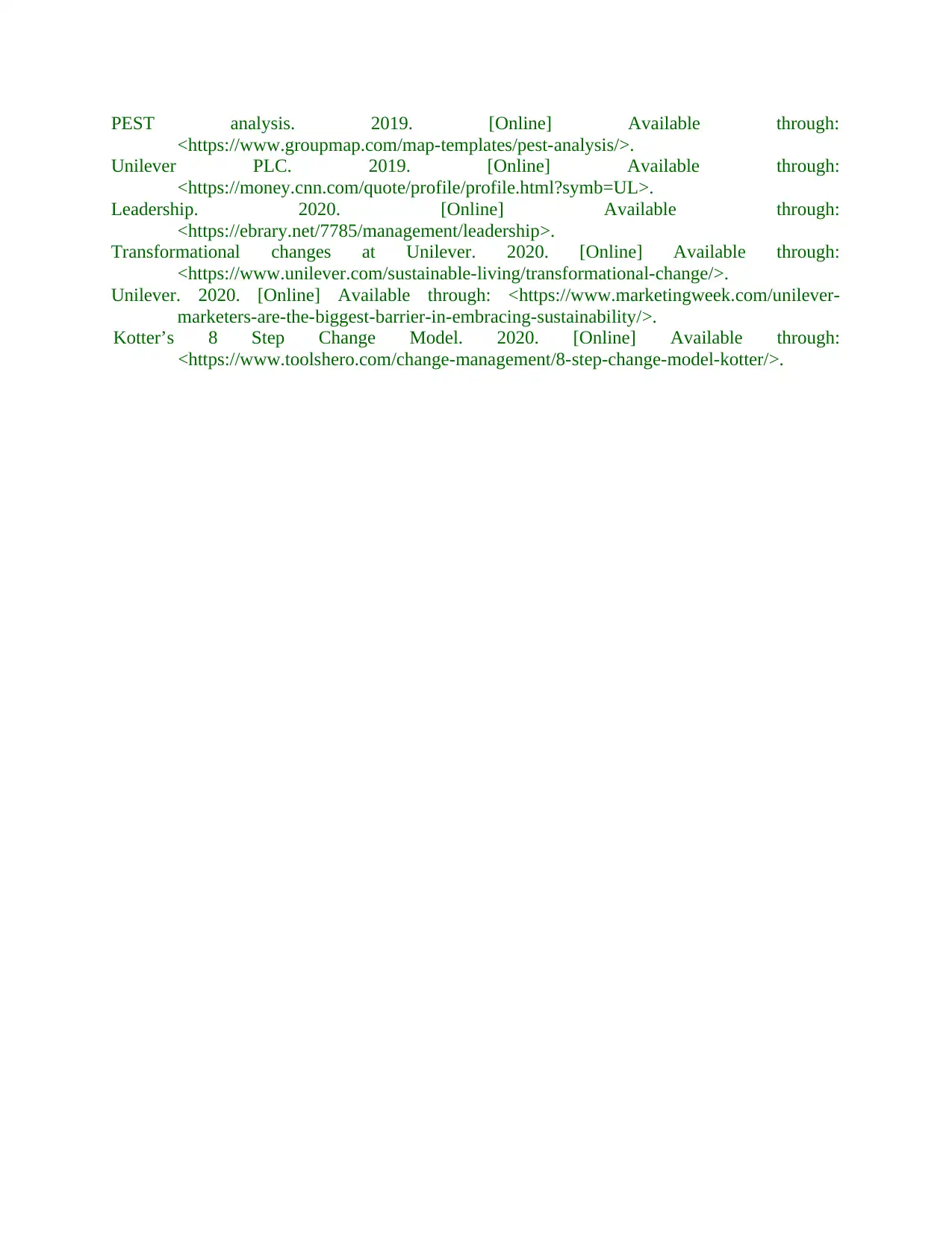
PEST analysis. 2019. [Online] Available through:
<https://www.groupmap.com/map-templates/pest-analysis/>.
Unilever PLC. 2019. [Online] Available through:
<https://money.cnn.com/quote/profile/profile.html?symb=UL>.
Leadership. 2020. [Online] Available through:
<https://ebrary.net/7785/management/leadership>.
Transformational changes at Unilever. 2020. [Online] Available through:
<https://www.unilever.com/sustainable-living/transformational-change/>.
Unilever. 2020. [Online] Available through: <https://www.marketingweek.com/unilever-
marketers-are-the-biggest-barrier-in-embracing-sustainability/>.
Kotter’s 8 Step Change Model. 2020. [Online] Available through:
<https://www.toolshero.com/change-management/8-step-change-model-kotter/>.
<https://www.groupmap.com/map-templates/pest-analysis/>.
Unilever PLC. 2019. [Online] Available through:
<https://money.cnn.com/quote/profile/profile.html?symb=UL>.
Leadership. 2020. [Online] Available through:
<https://ebrary.net/7785/management/leadership>.
Transformational changes at Unilever. 2020. [Online] Available through:
<https://www.unilever.com/sustainable-living/transformational-change/>.
Unilever. 2020. [Online] Available through: <https://www.marketingweek.com/unilever-
marketers-are-the-biggest-barrier-in-embracing-sustainability/>.
Kotter’s 8 Step Change Model. 2020. [Online] Available through:
<https://www.toolshero.com/change-management/8-step-change-model-kotter/>.
1 out of 24
Related Documents
Your All-in-One AI-Powered Toolkit for Academic Success.
+13062052269
info@desklib.com
Available 24*7 on WhatsApp / Email
![[object Object]](/_next/static/media/star-bottom.7253800d.svg)
Unlock your academic potential
© 2024 | Zucol Services PVT LTD | All rights reserved.




